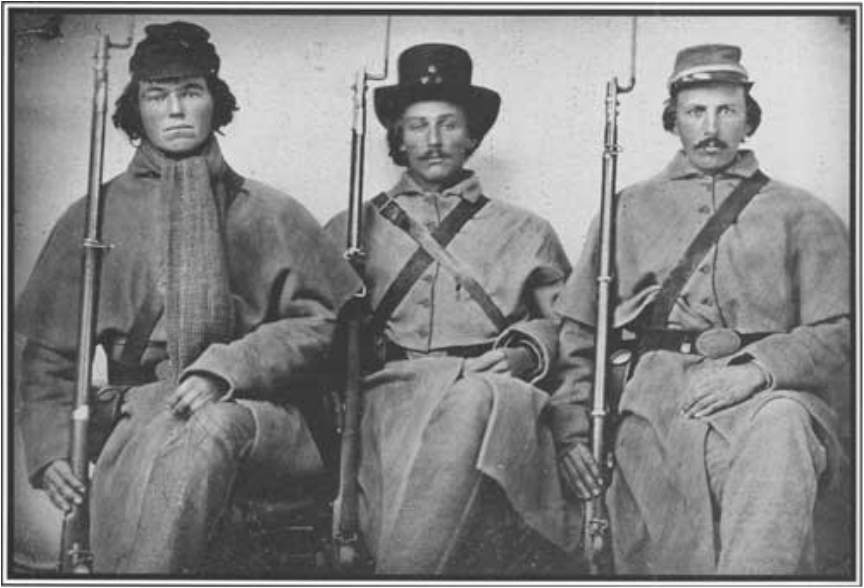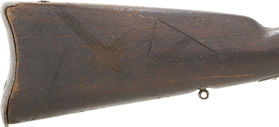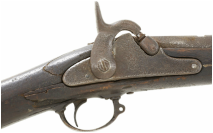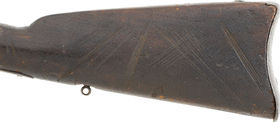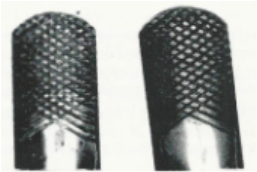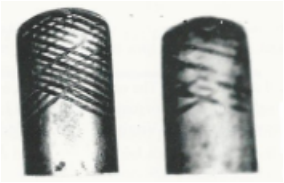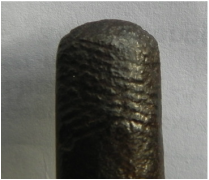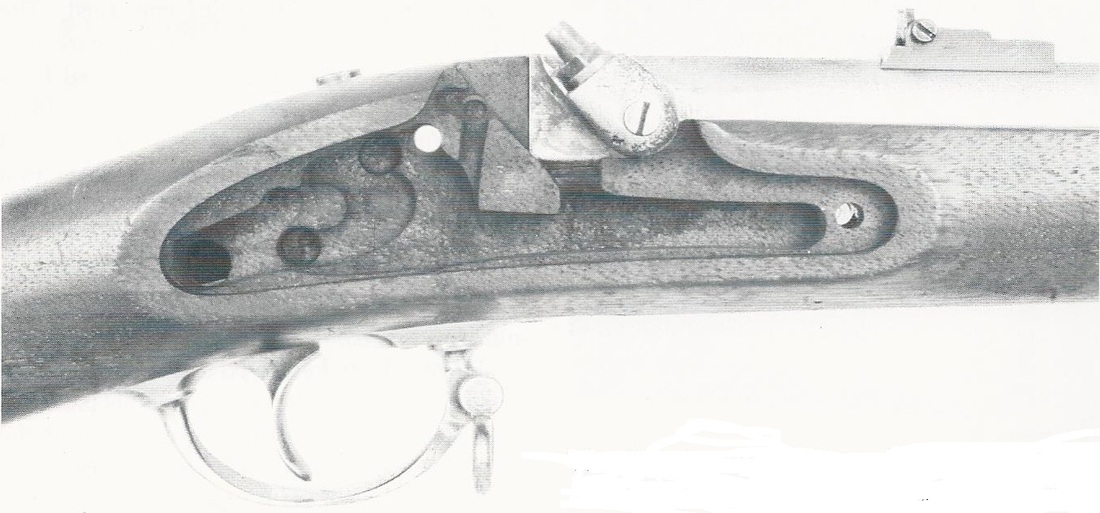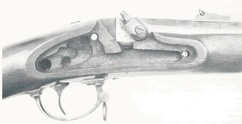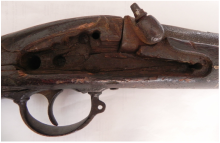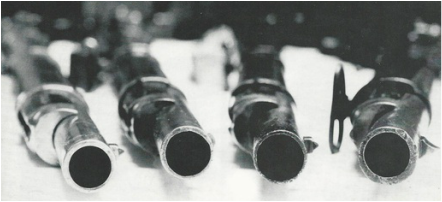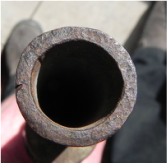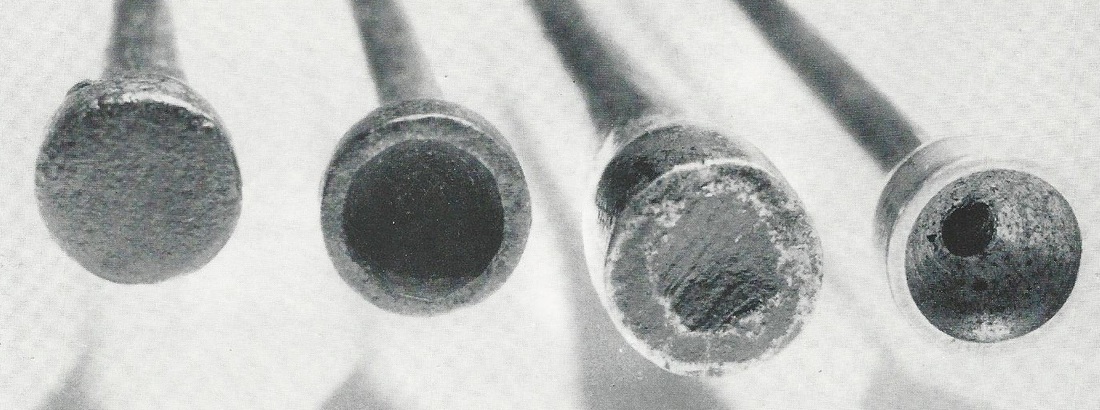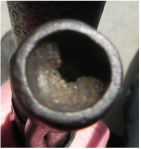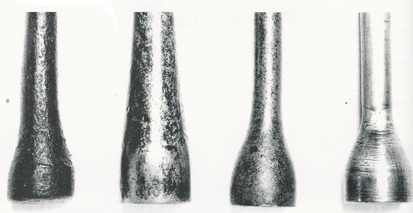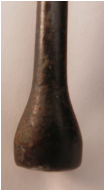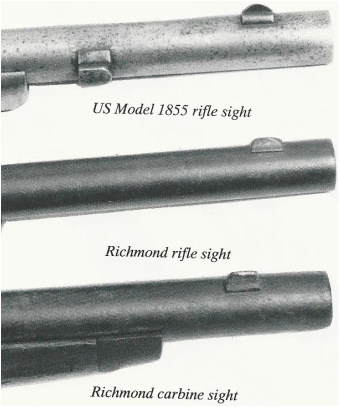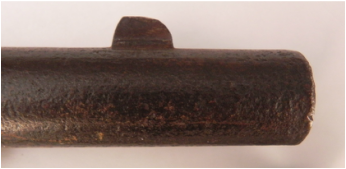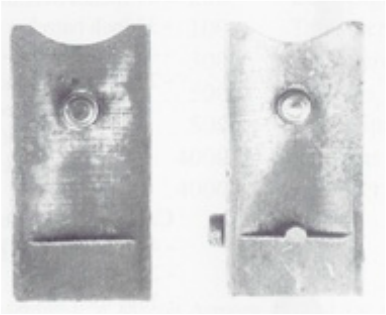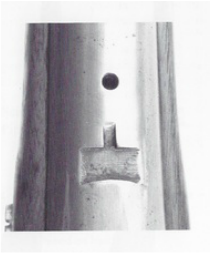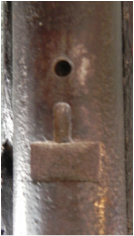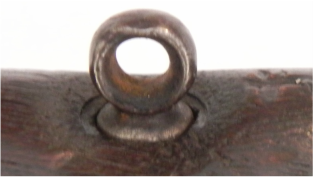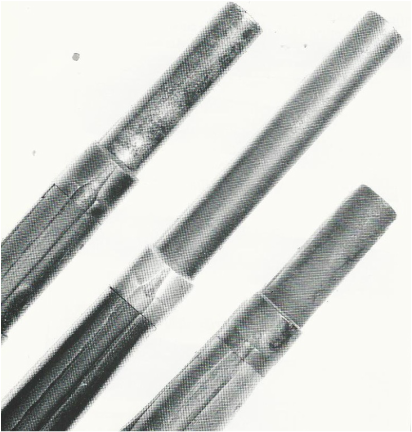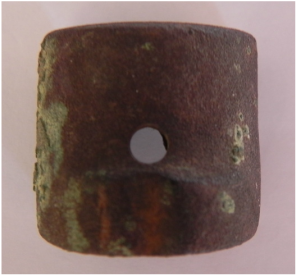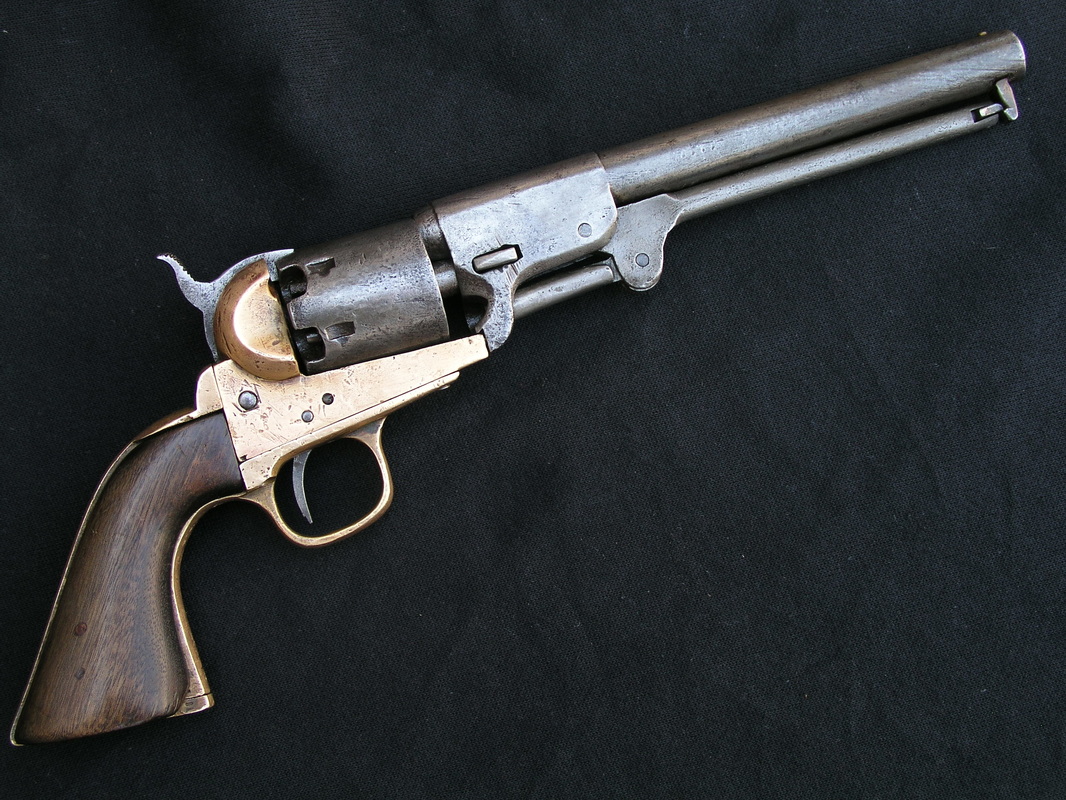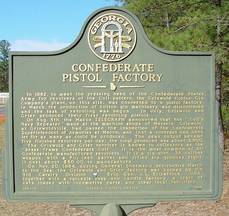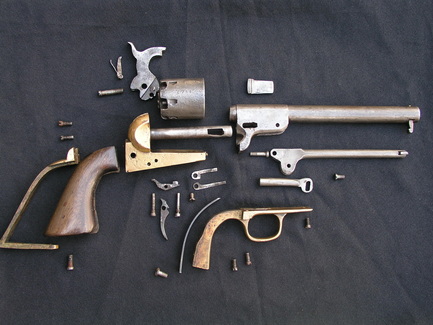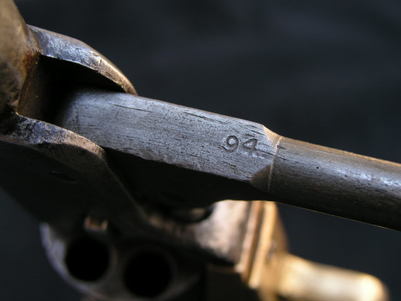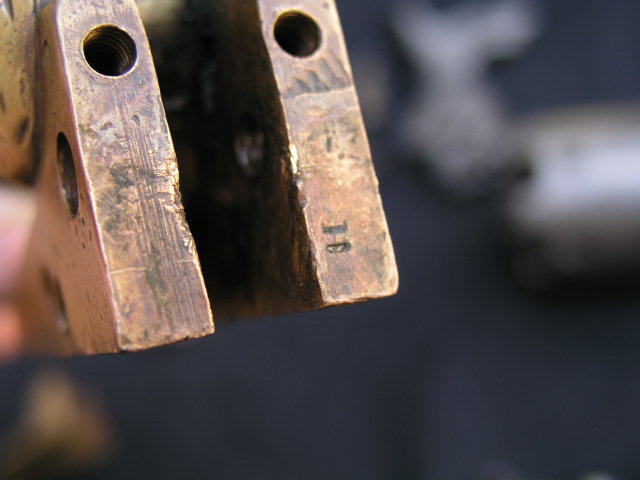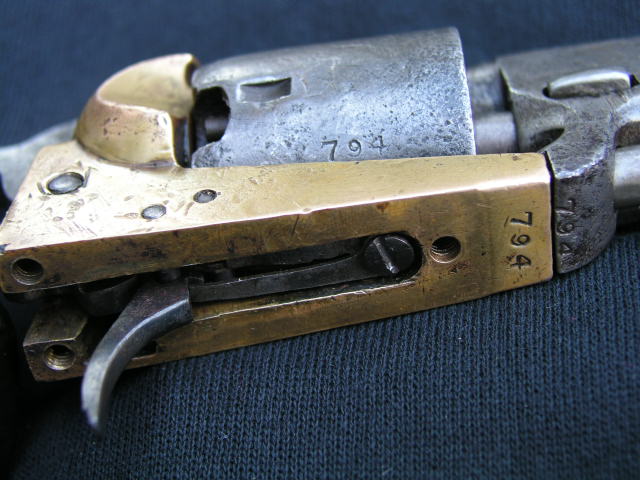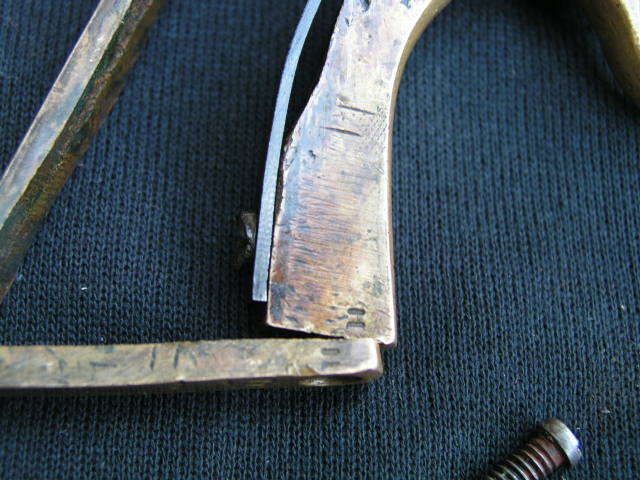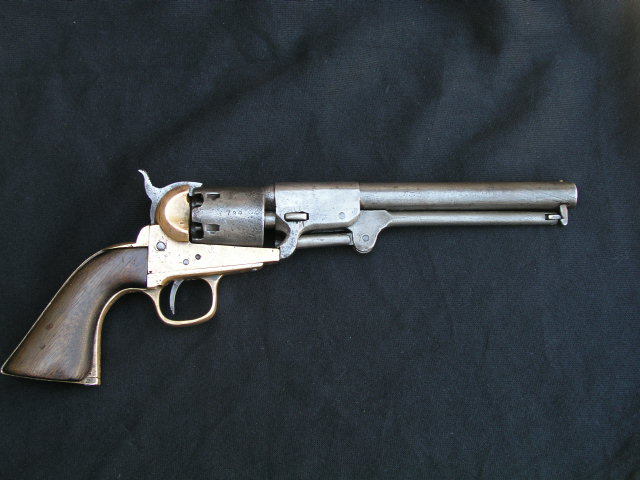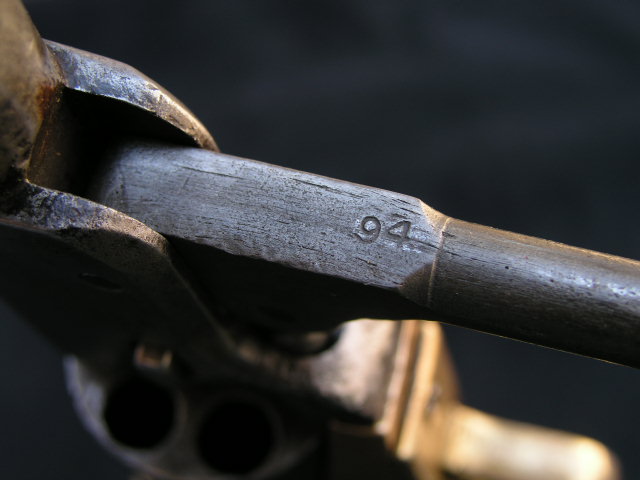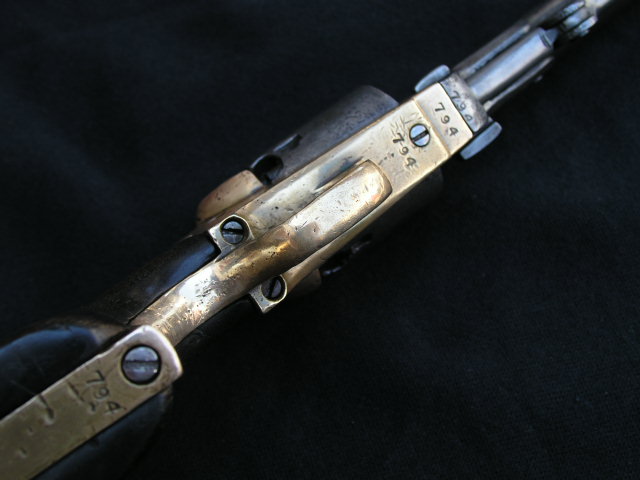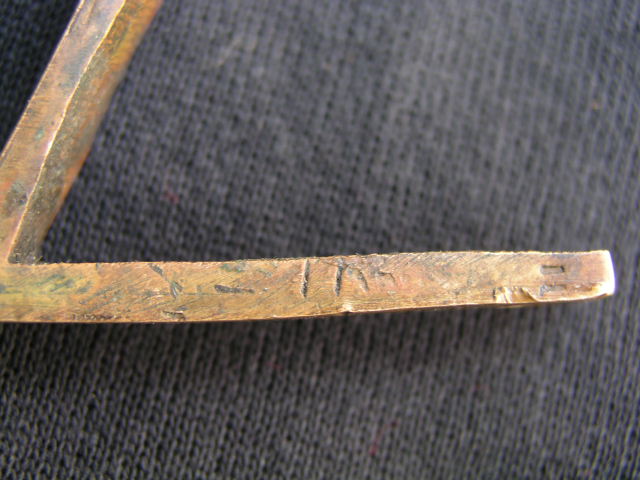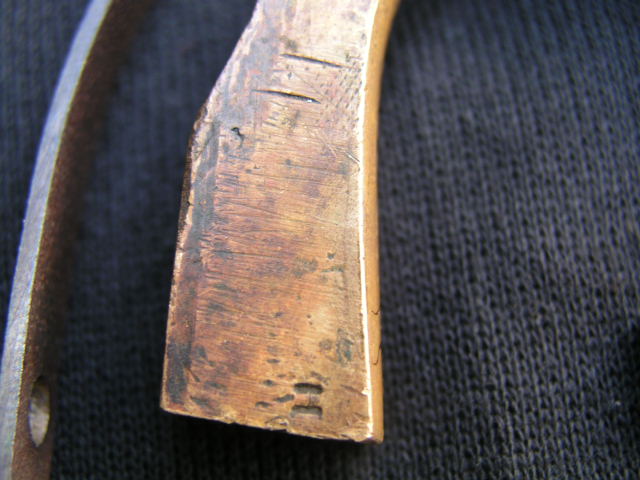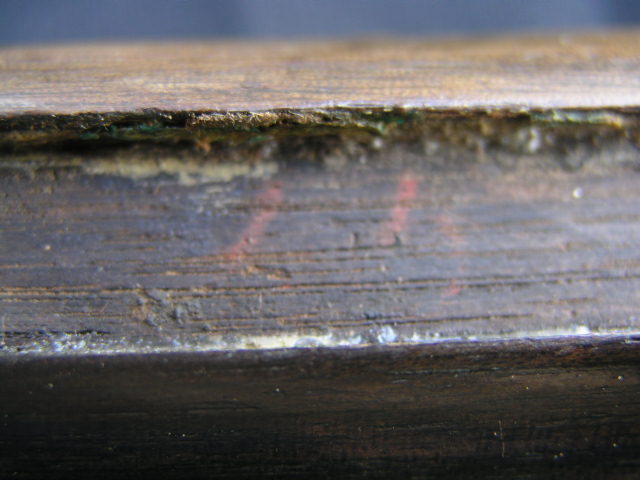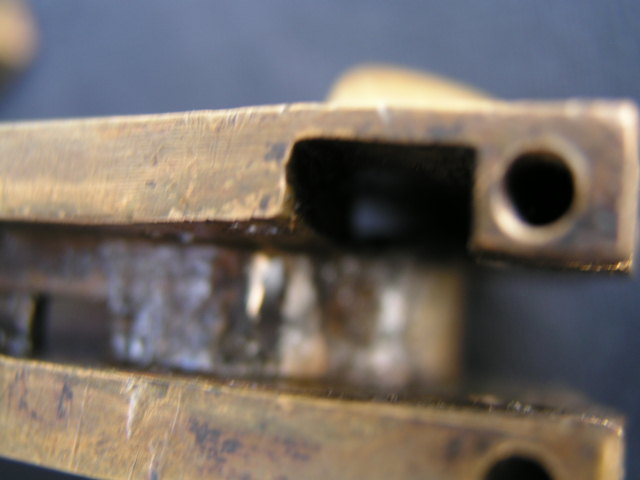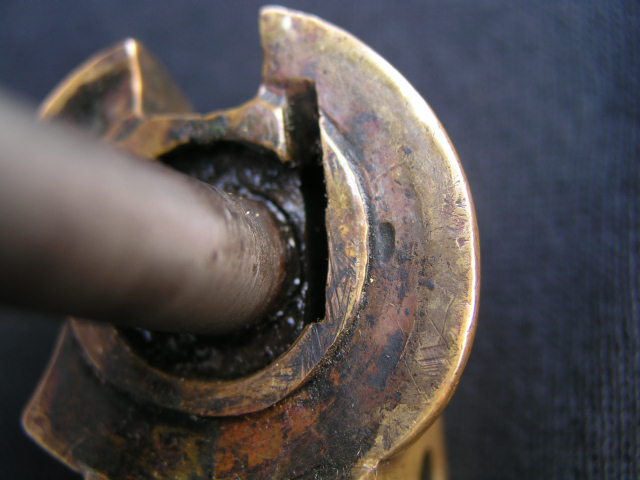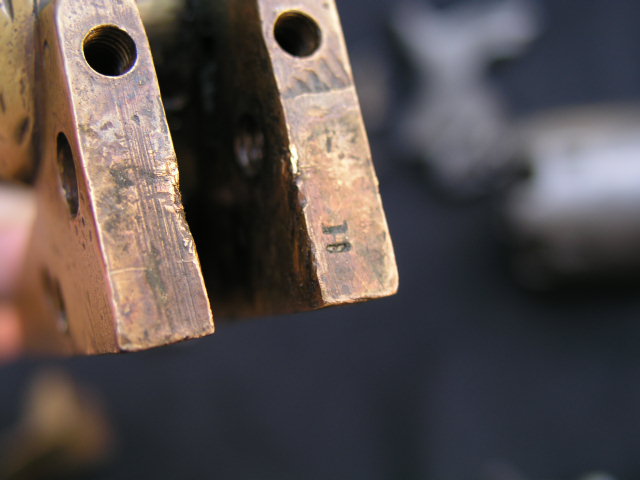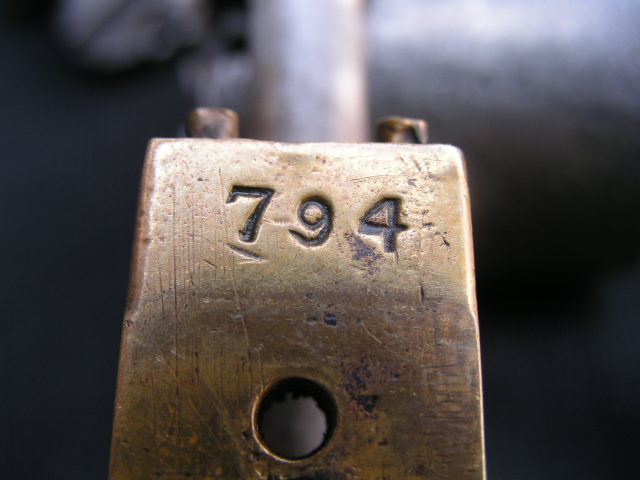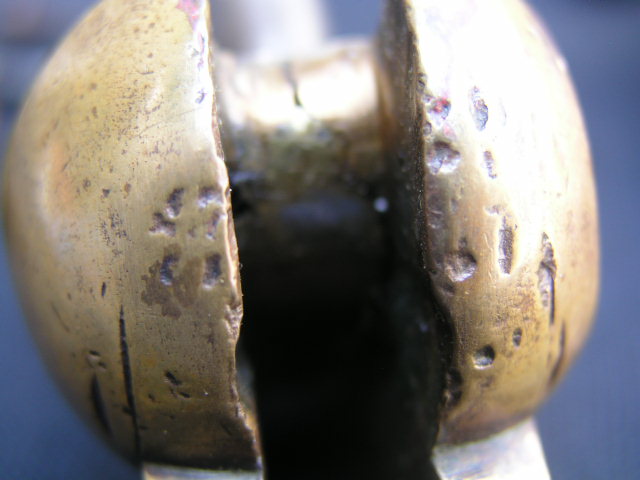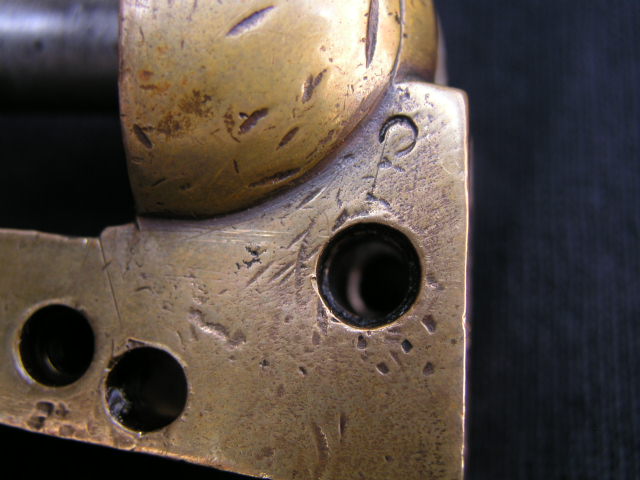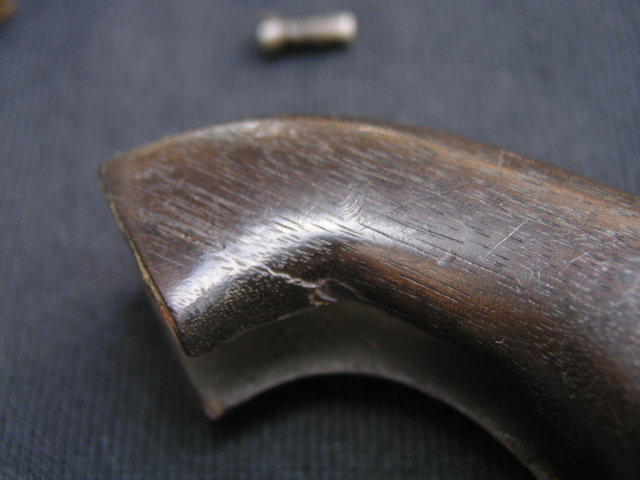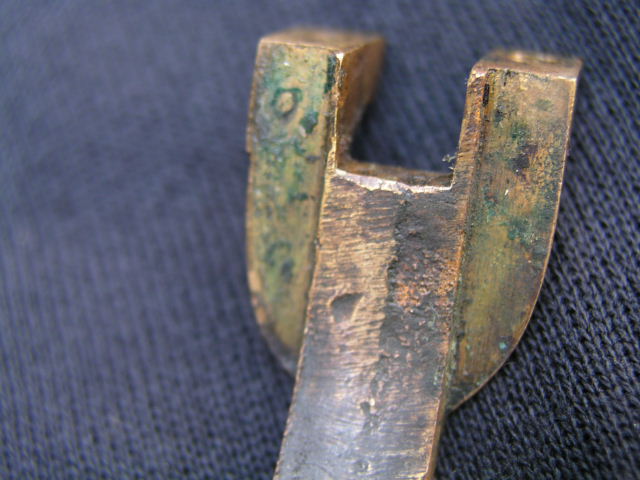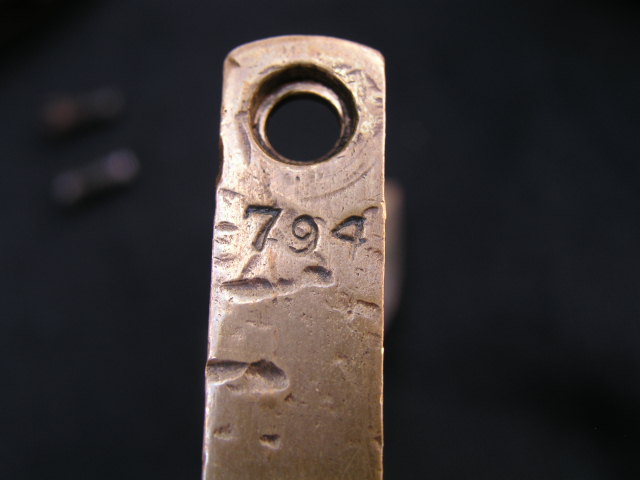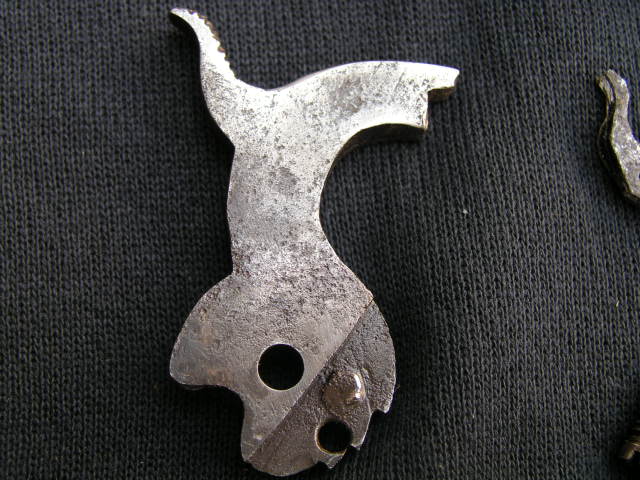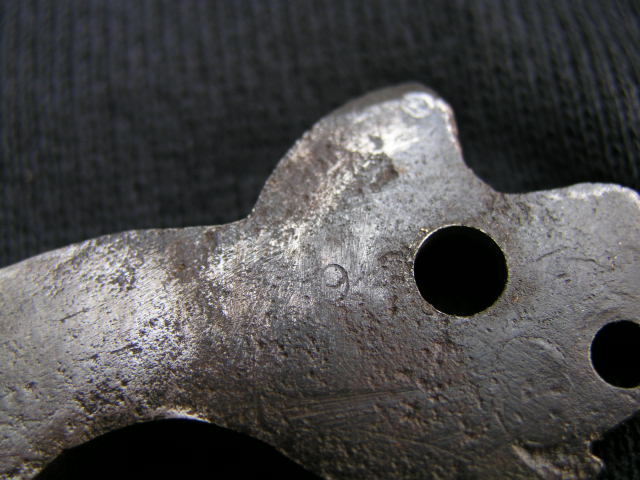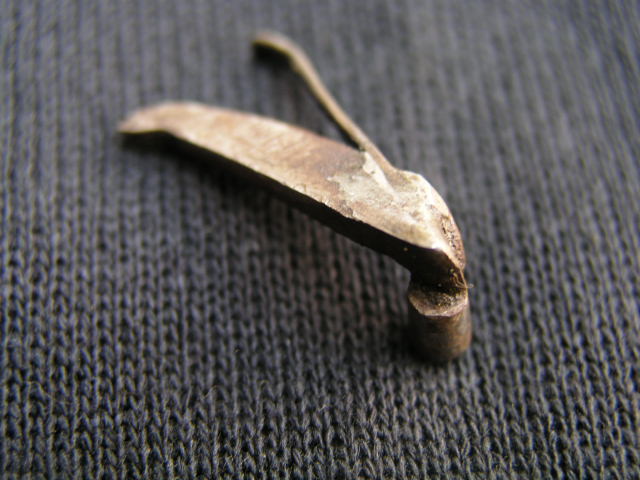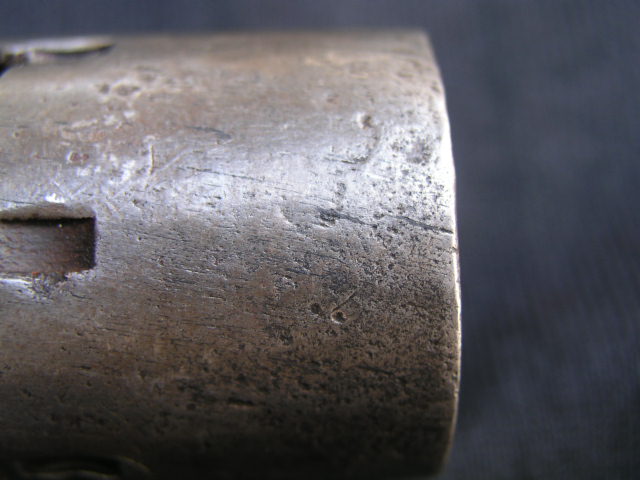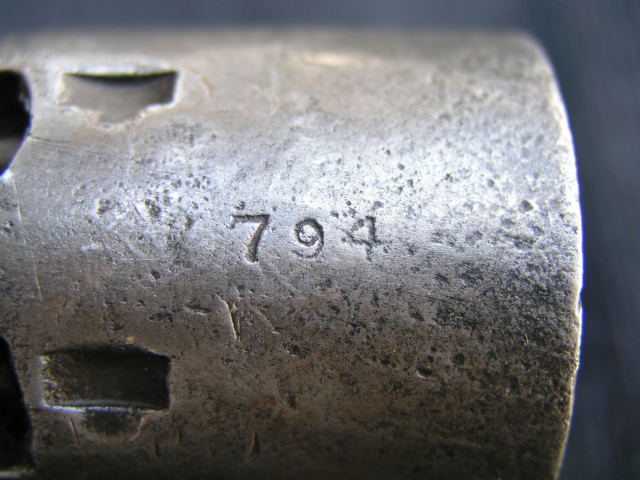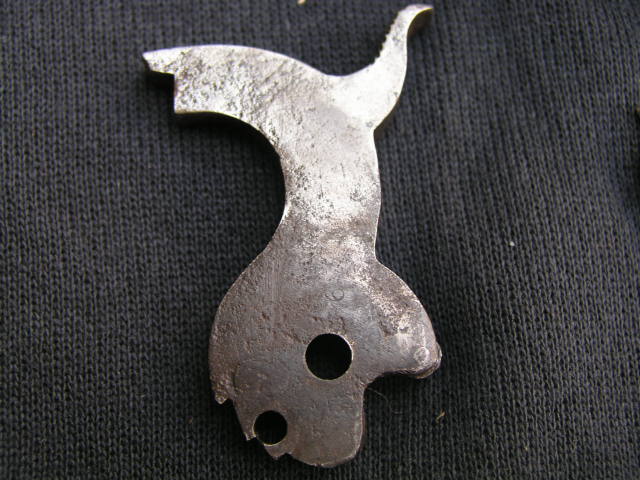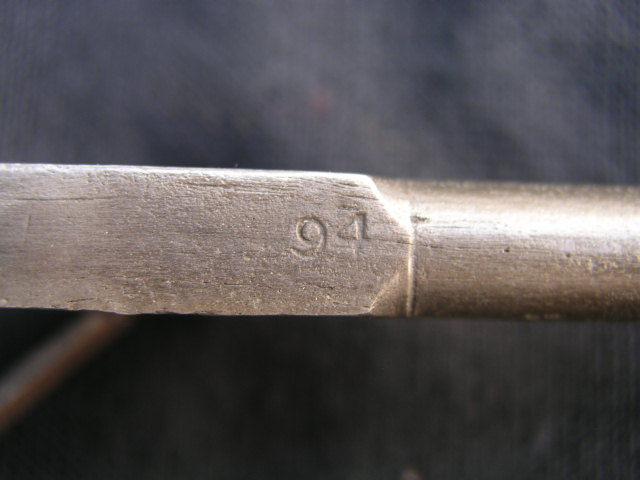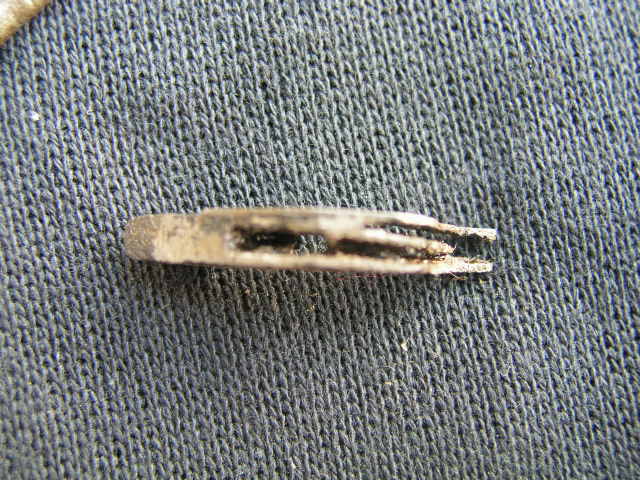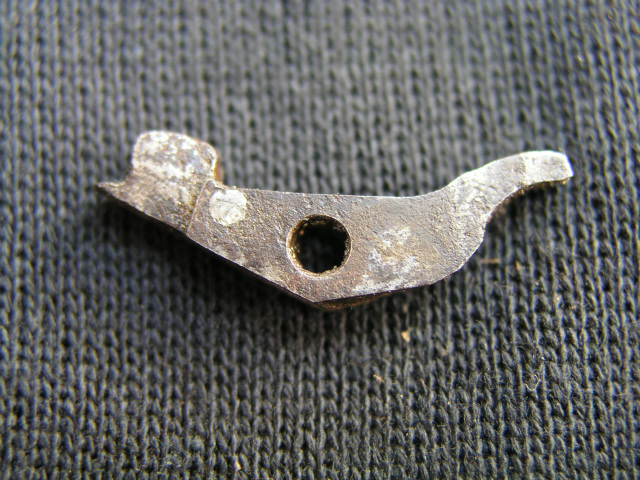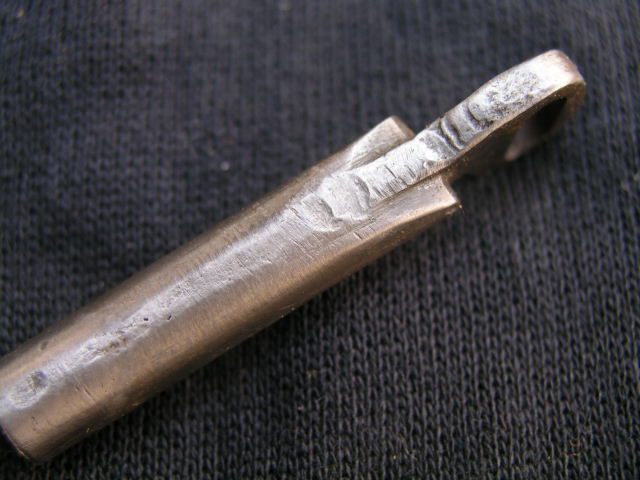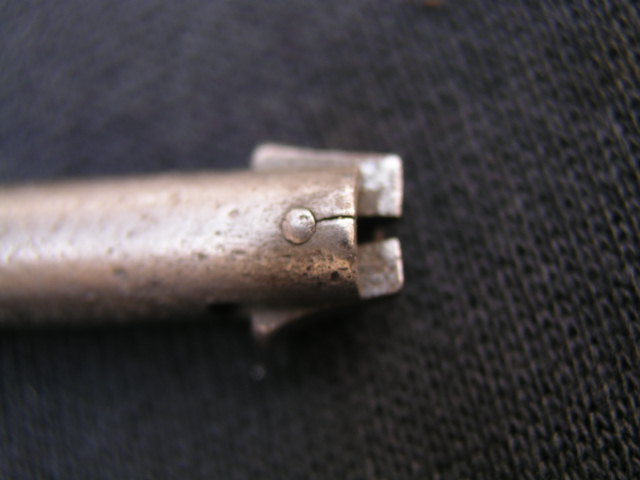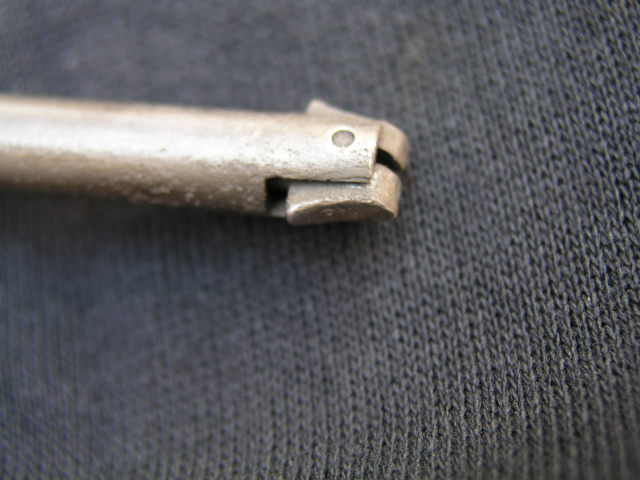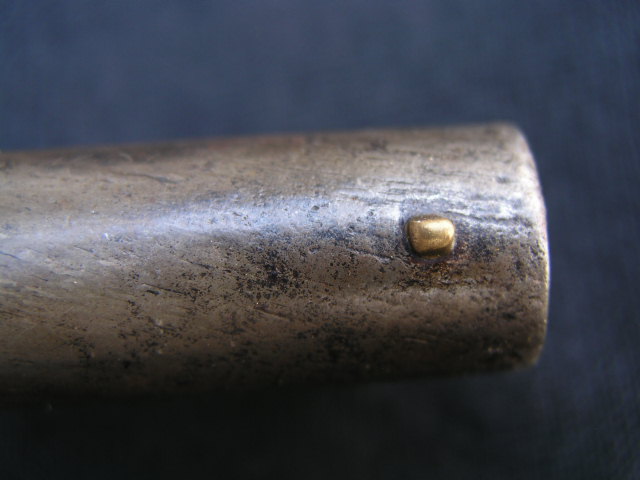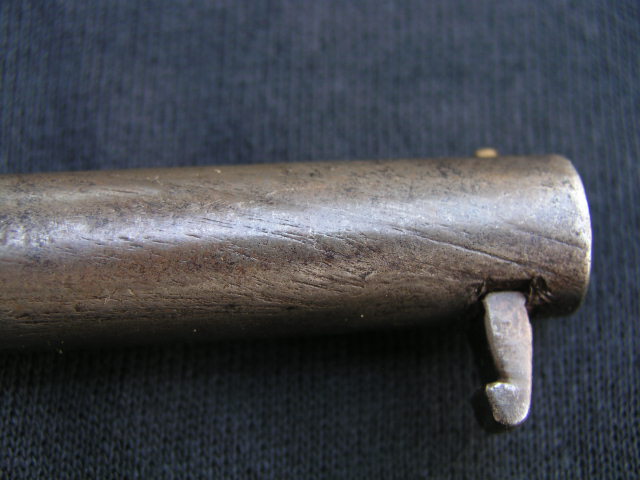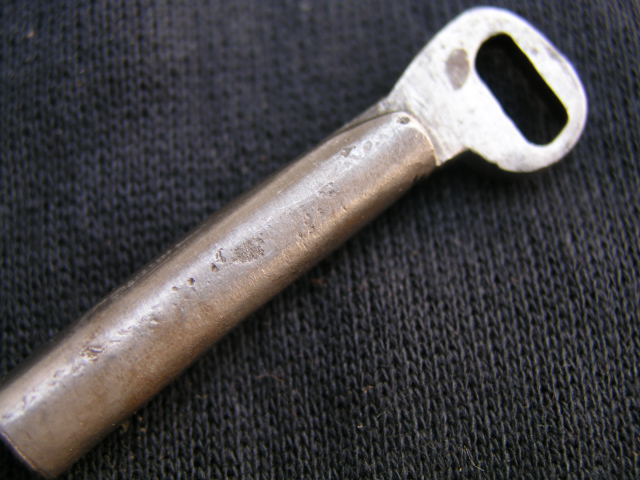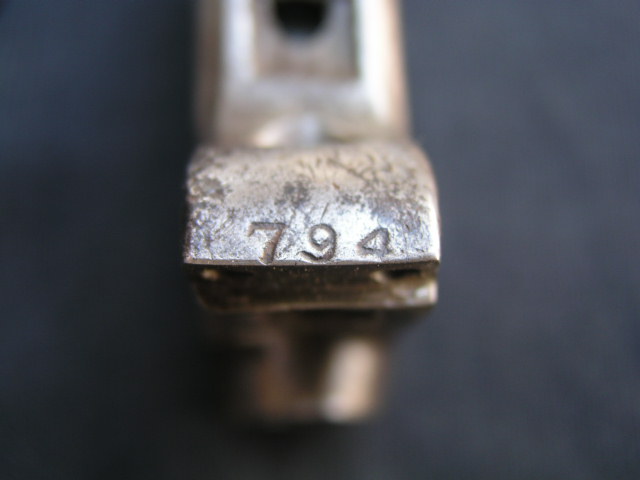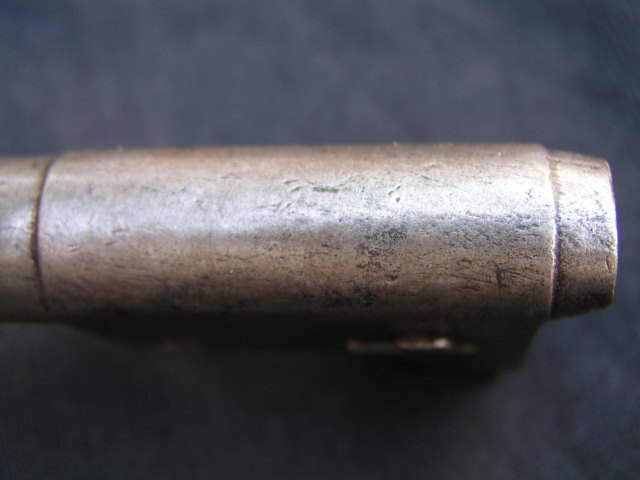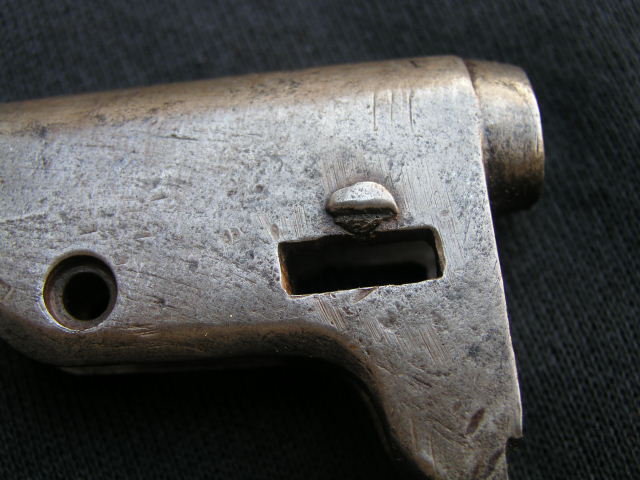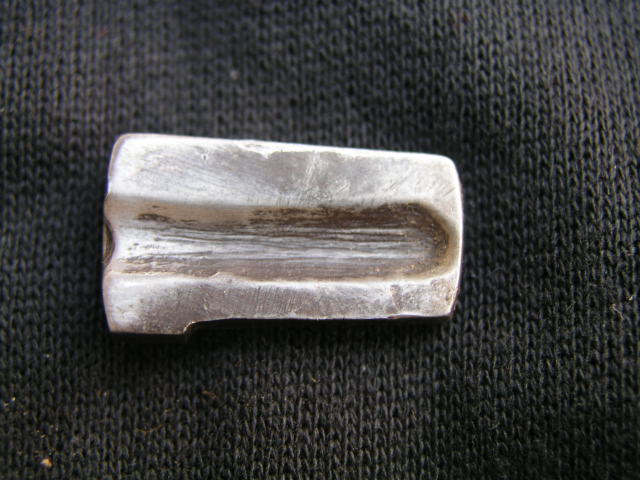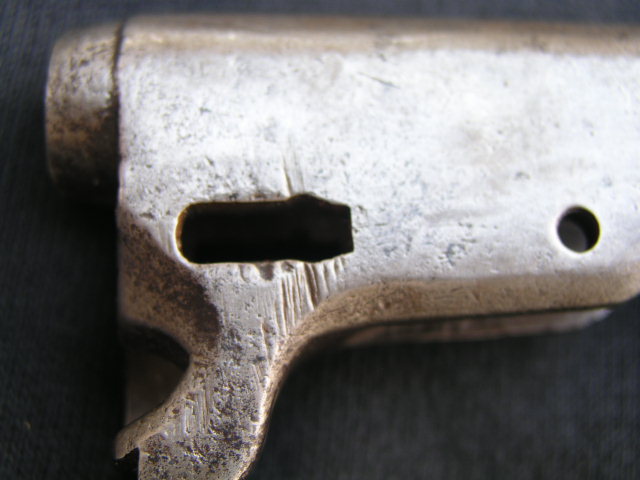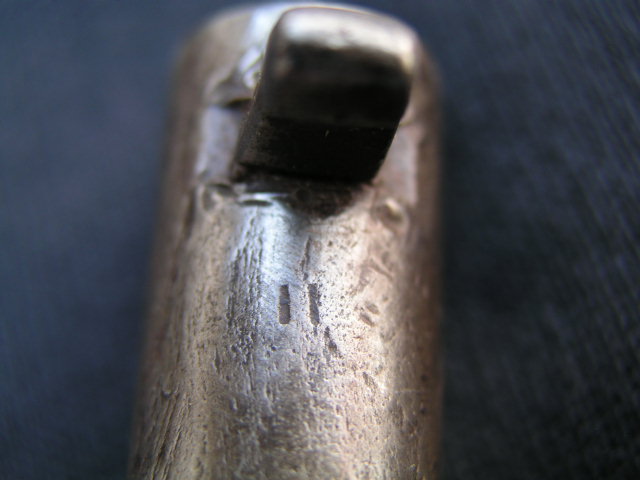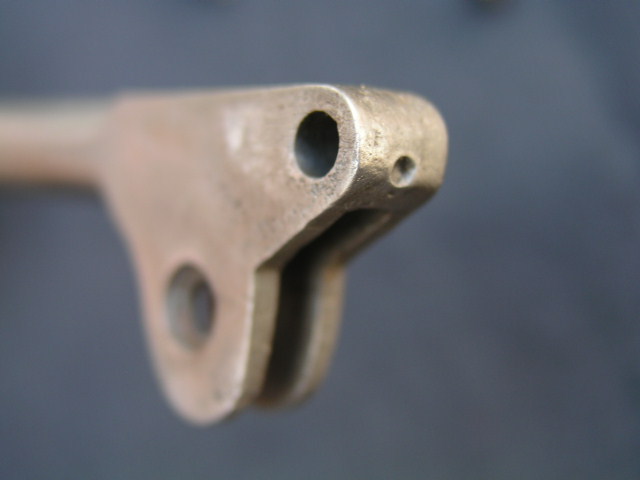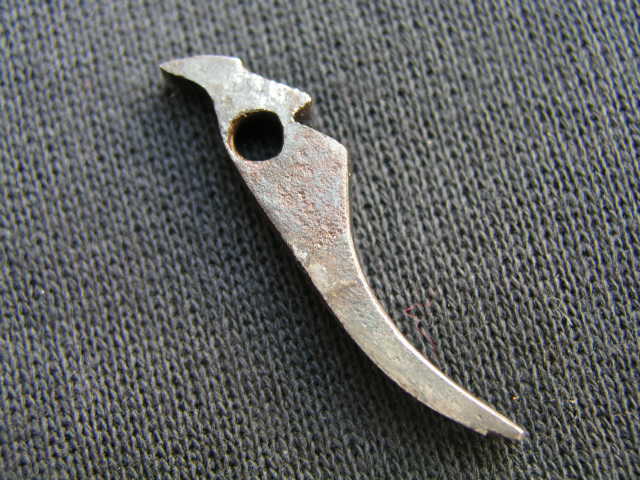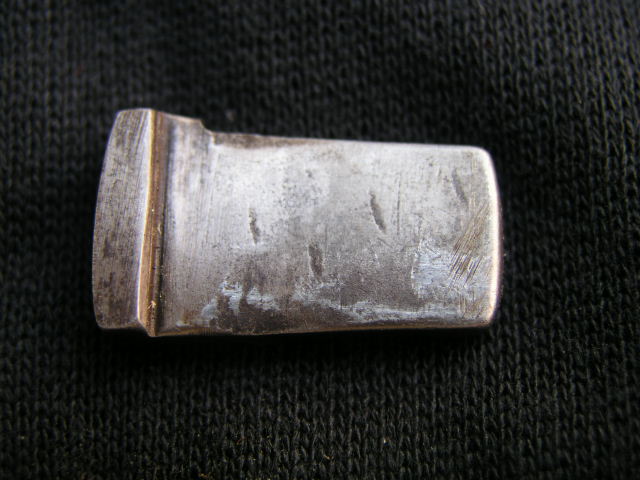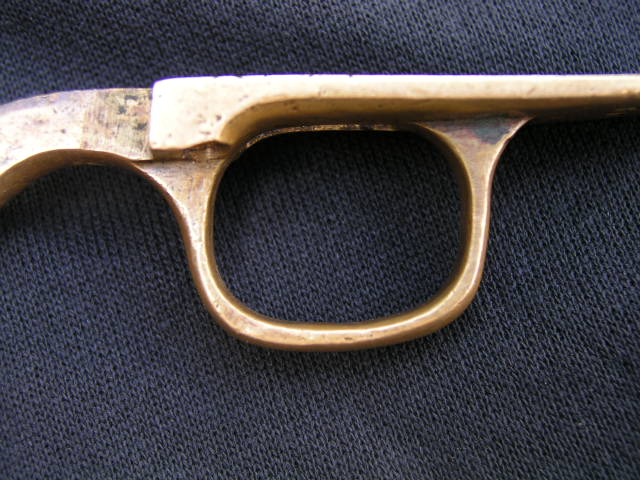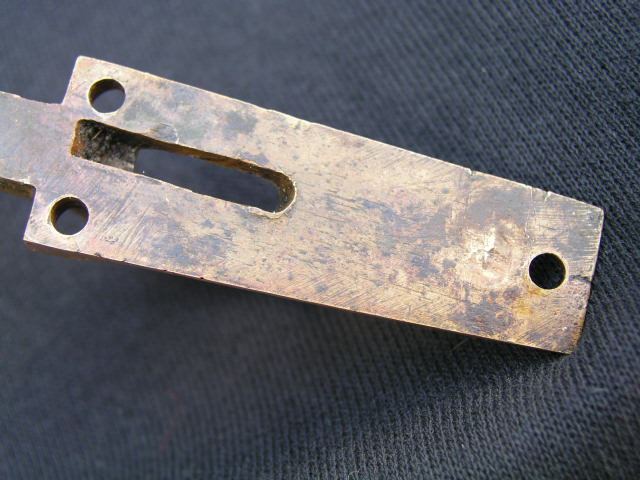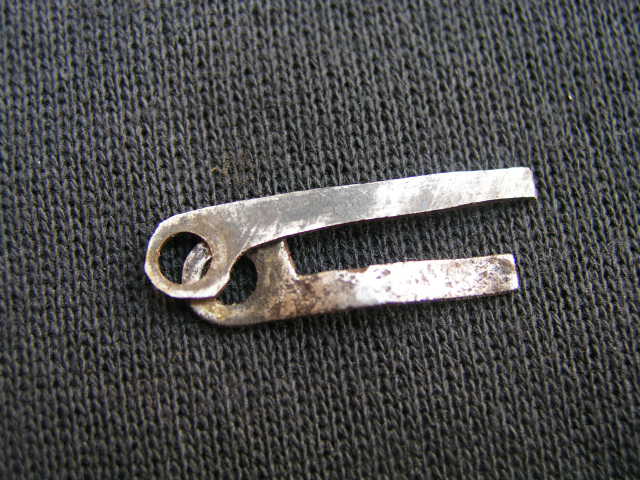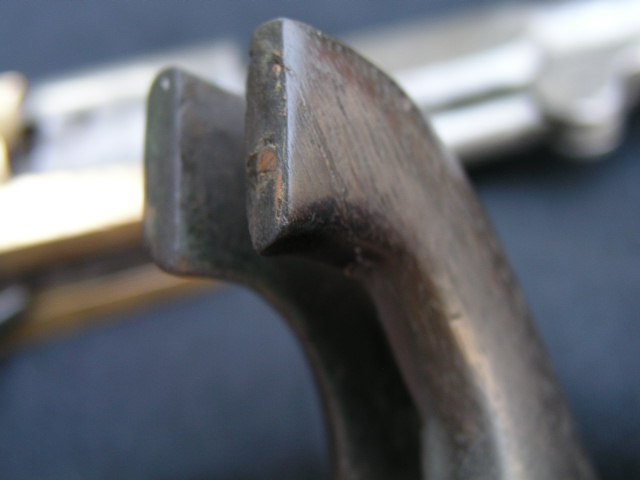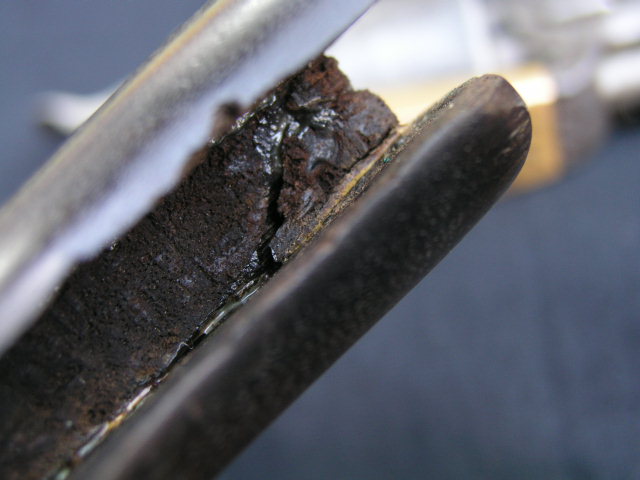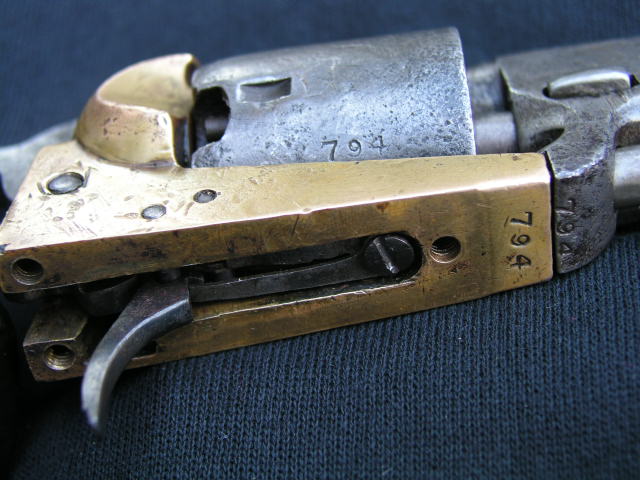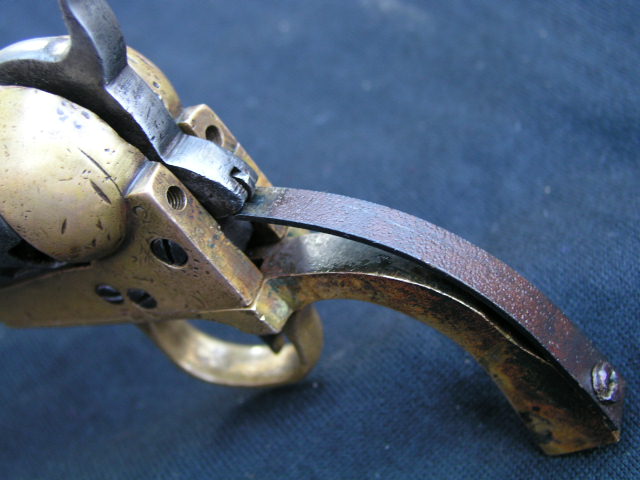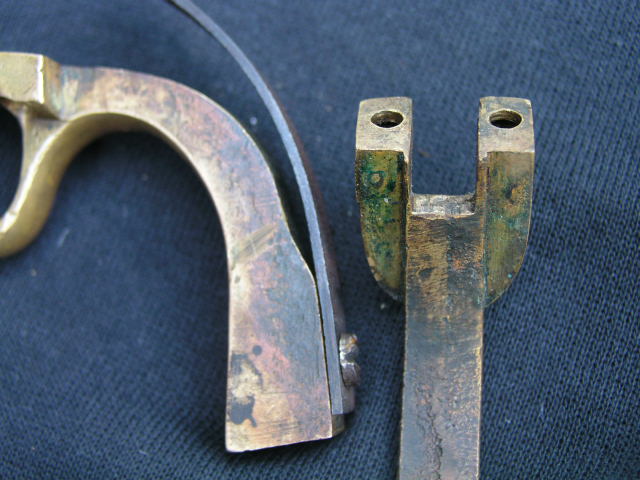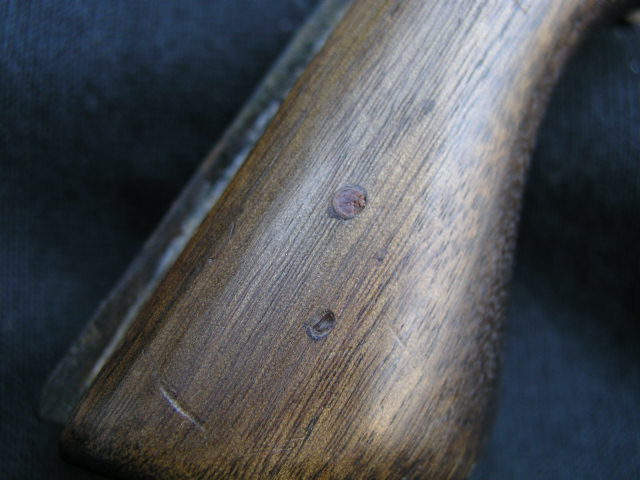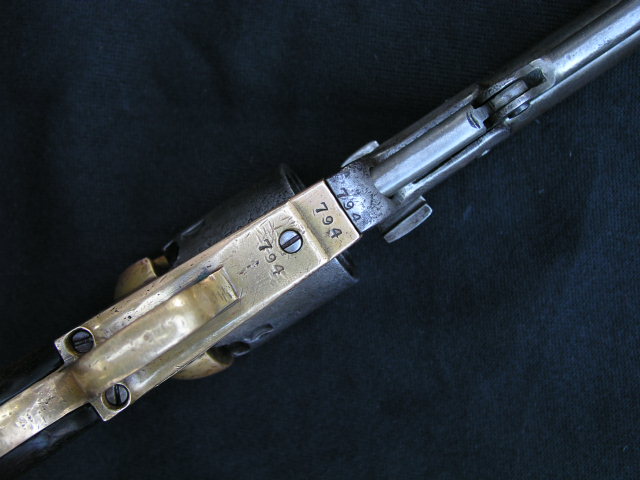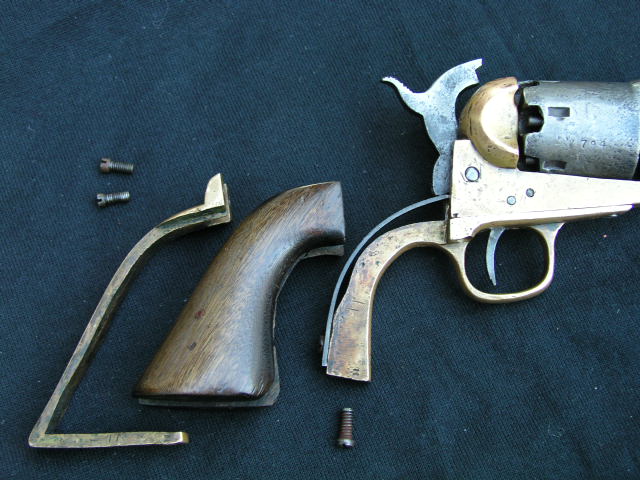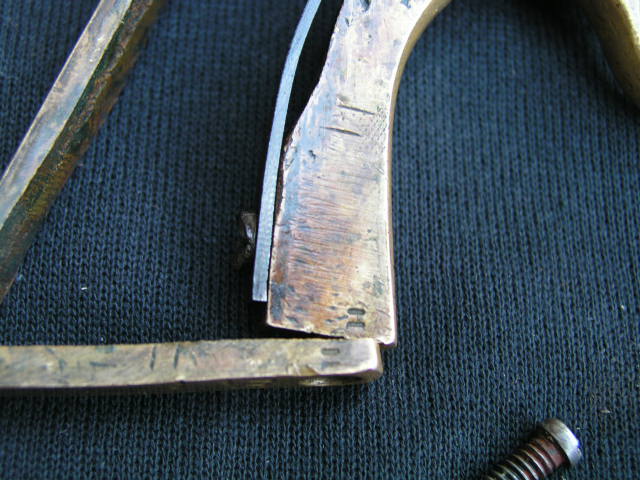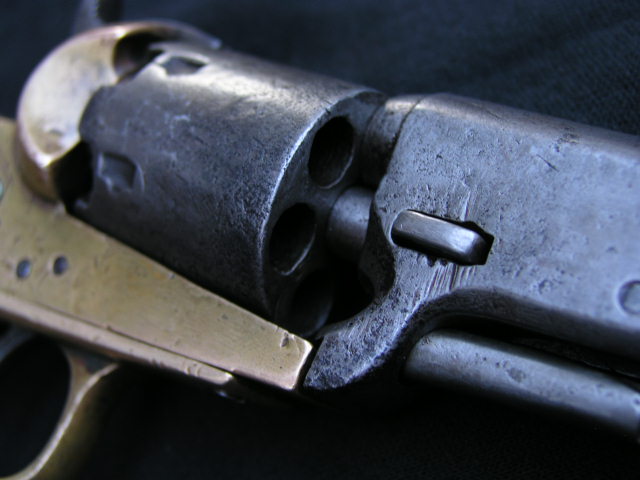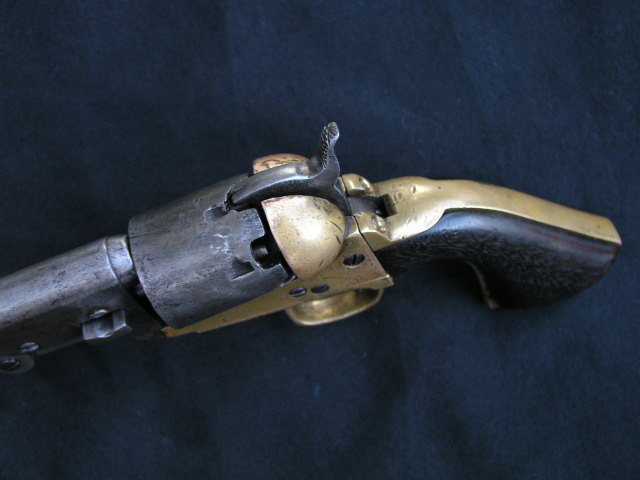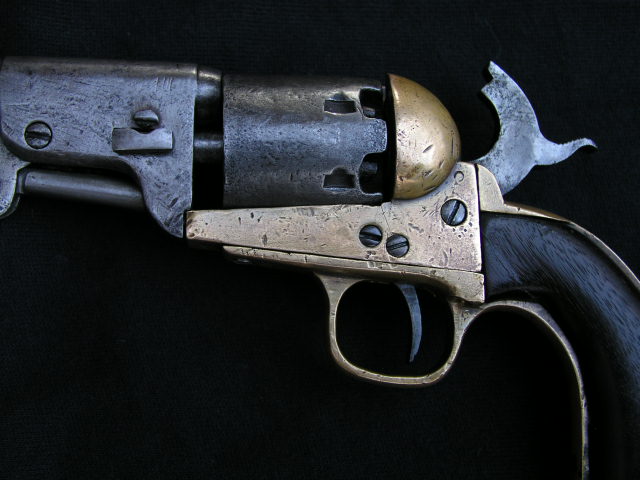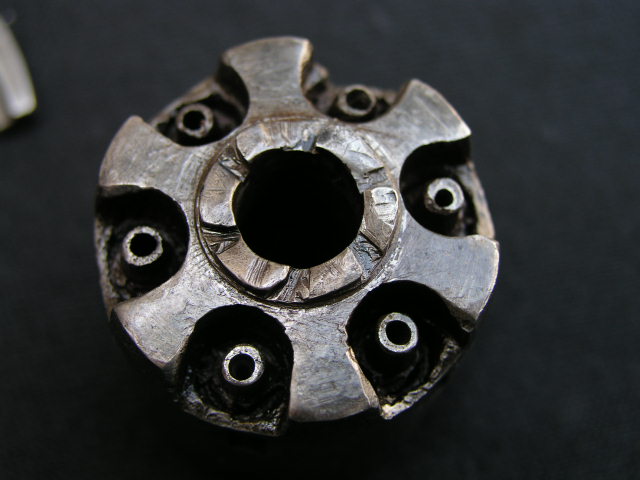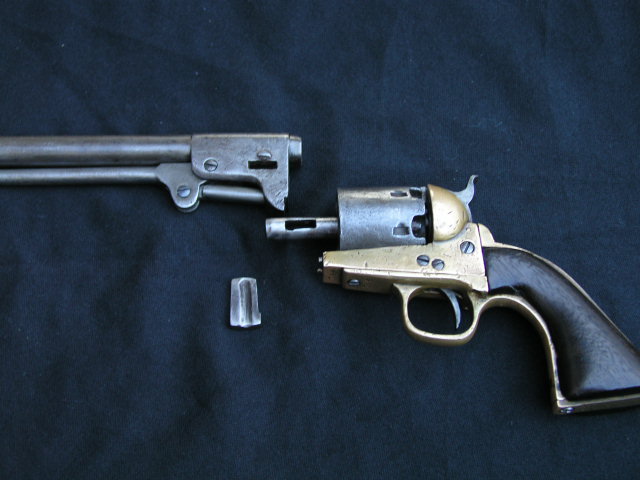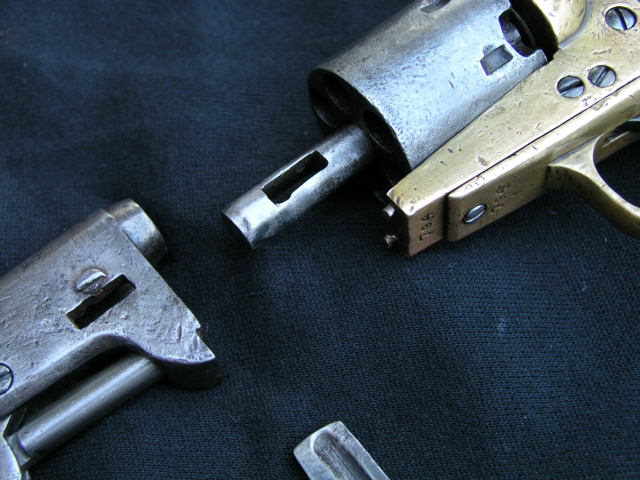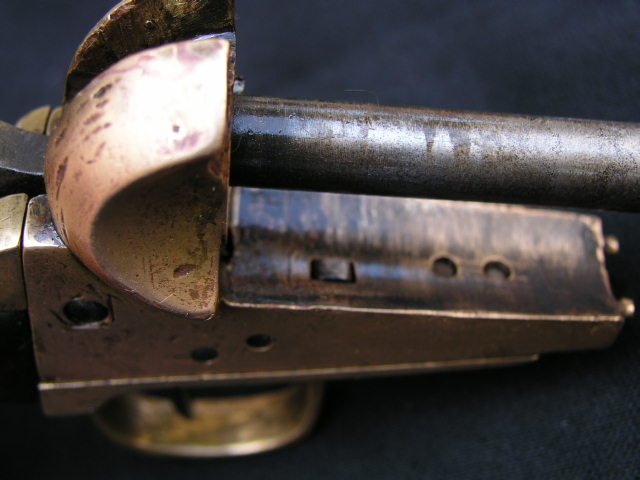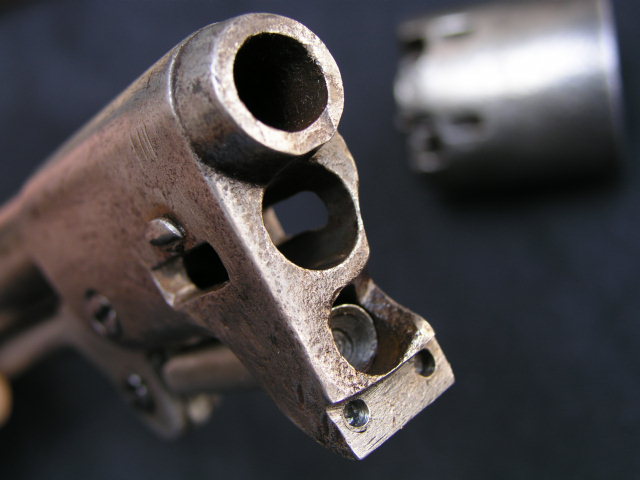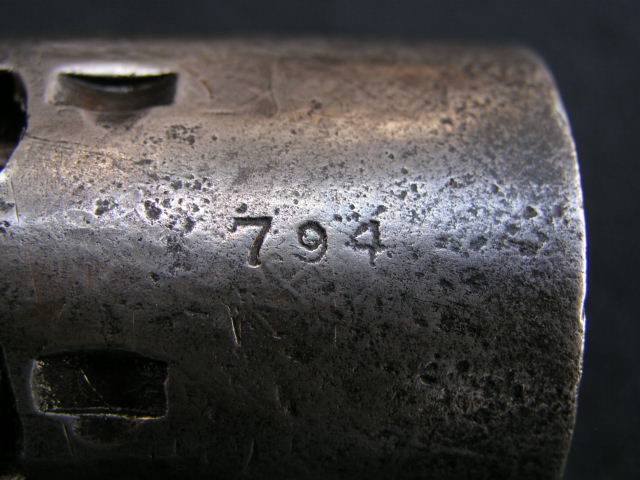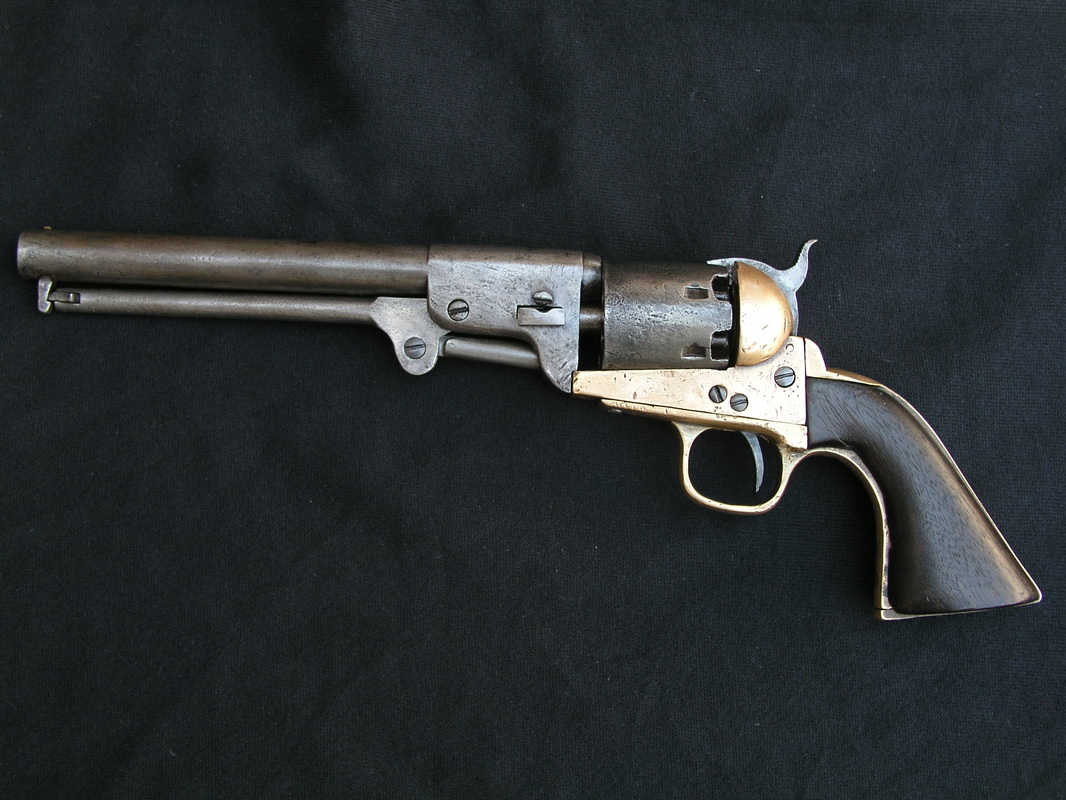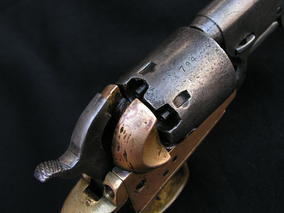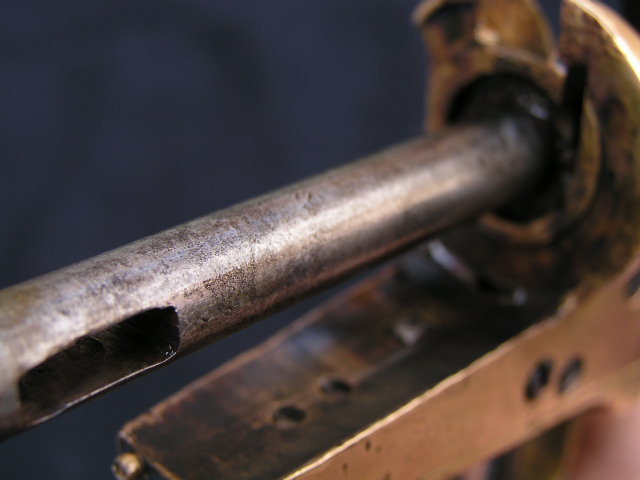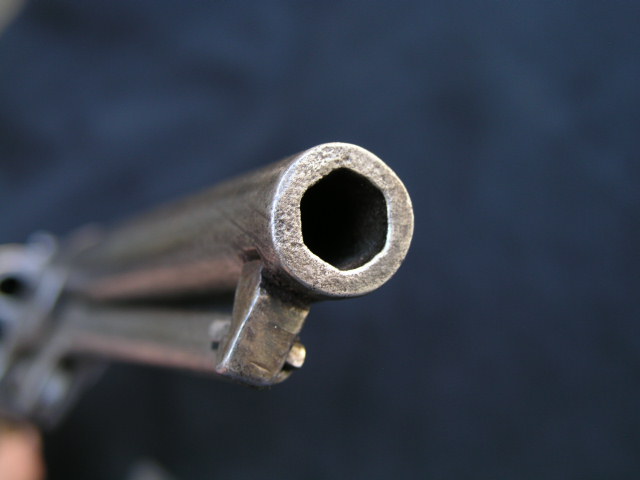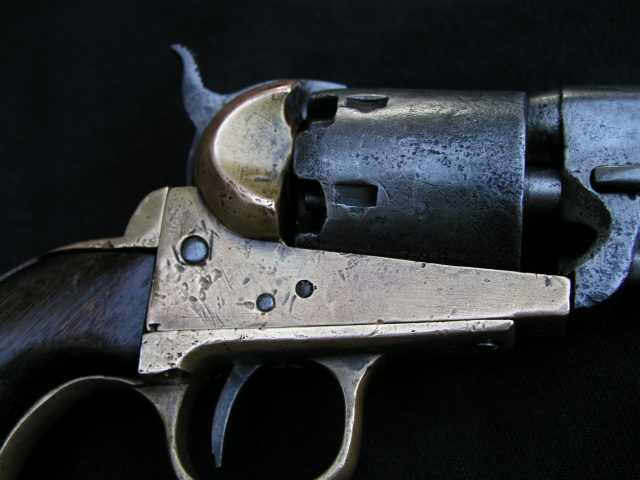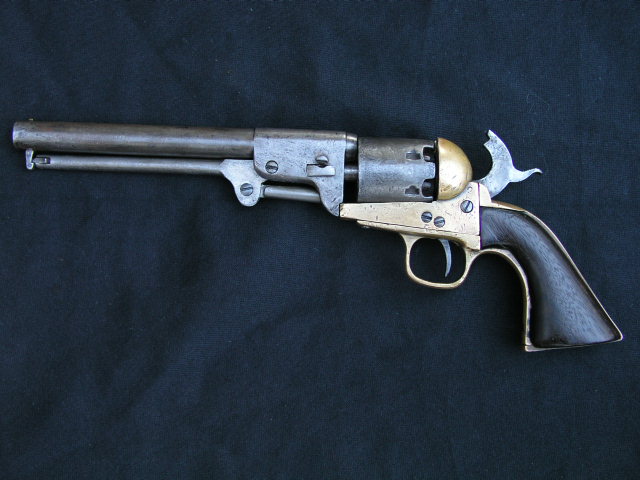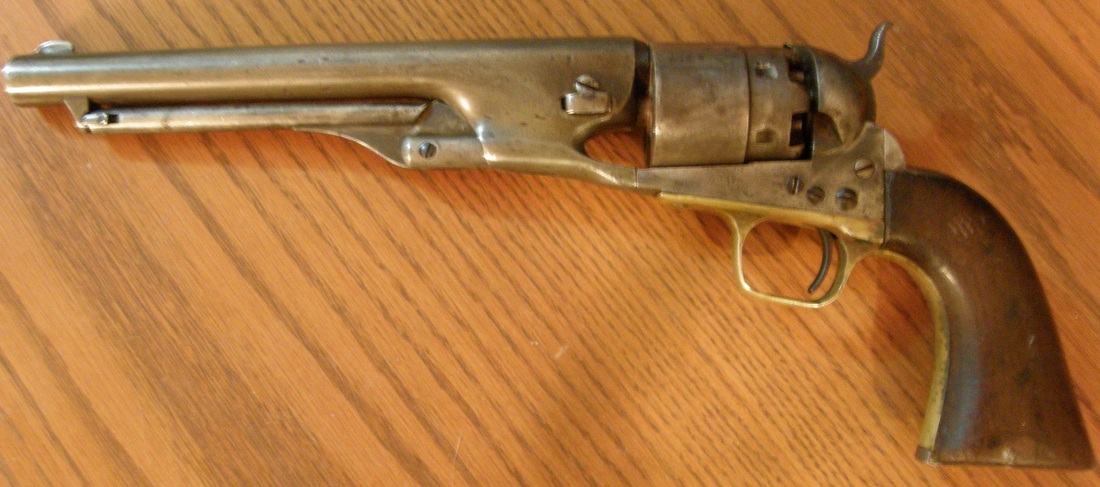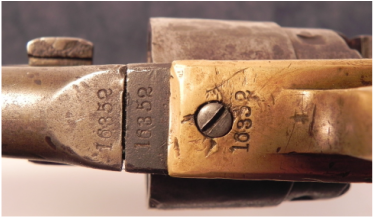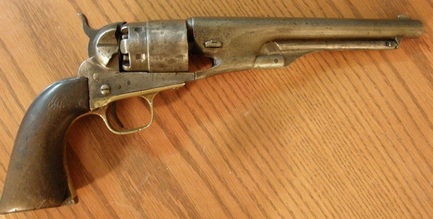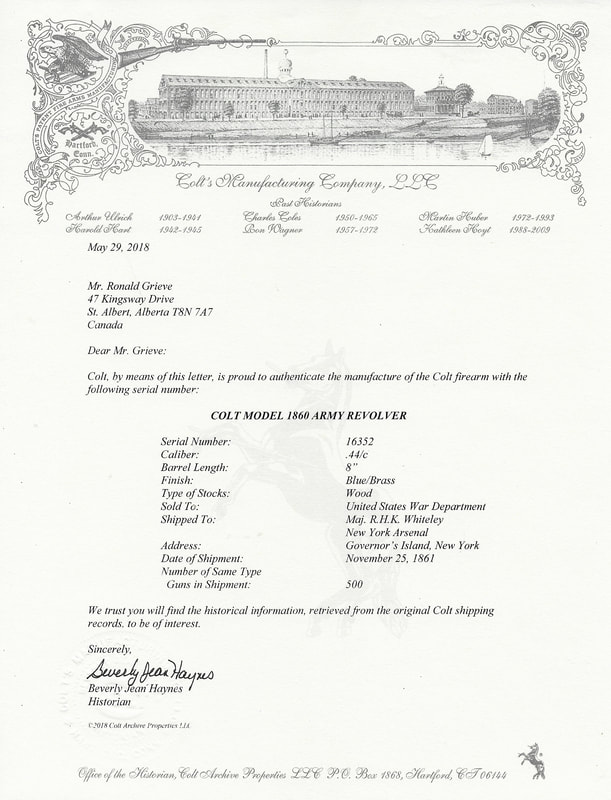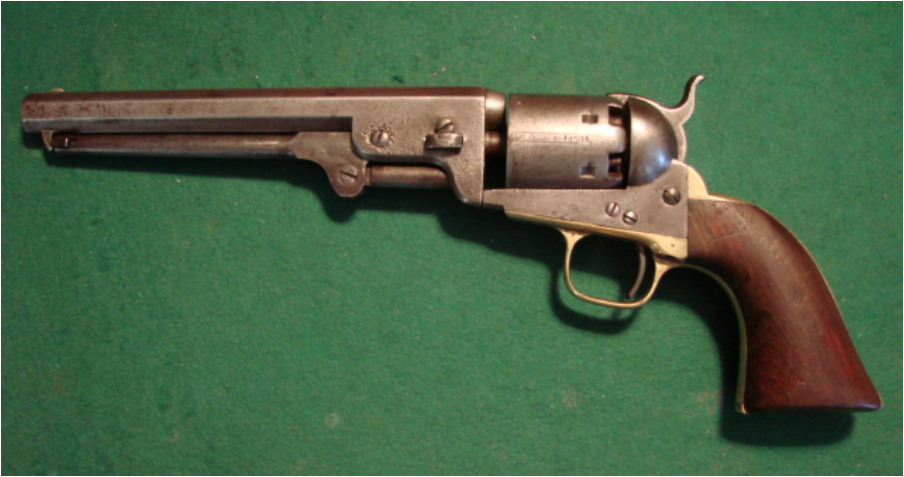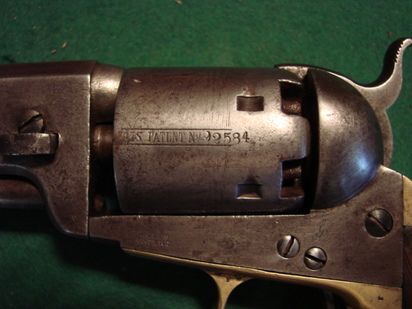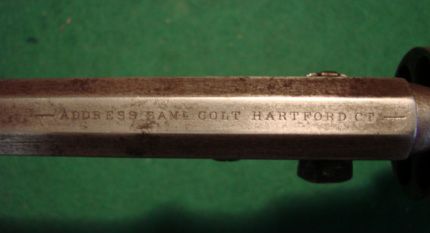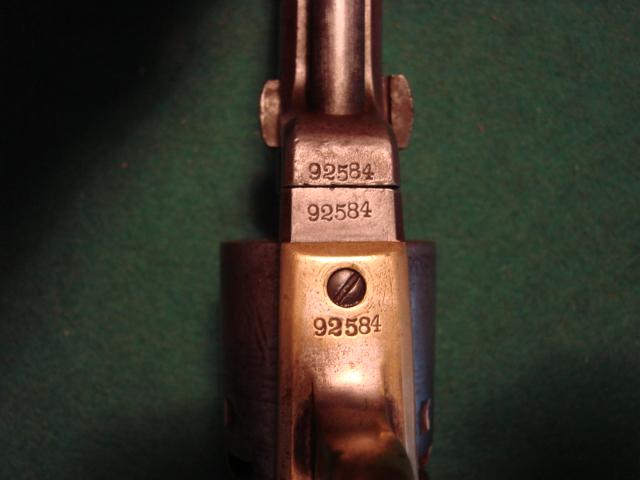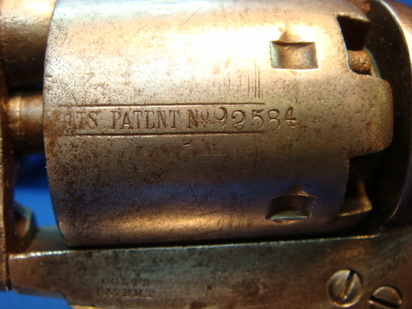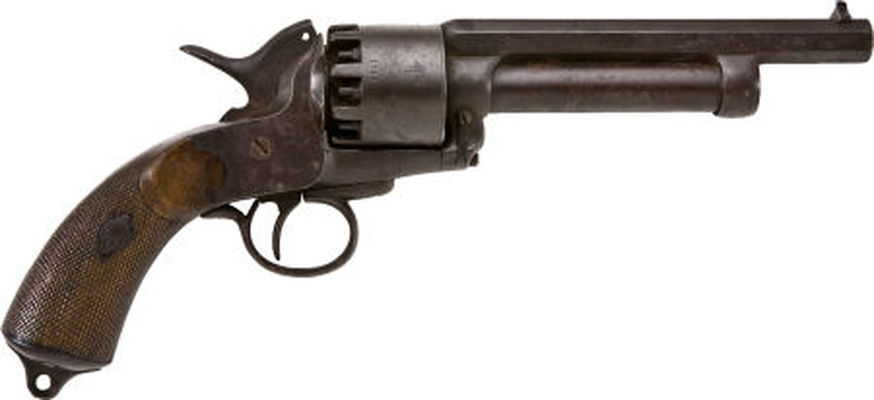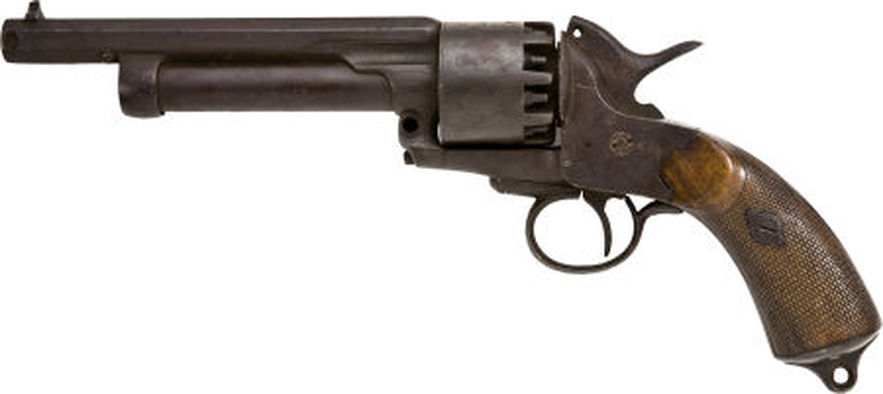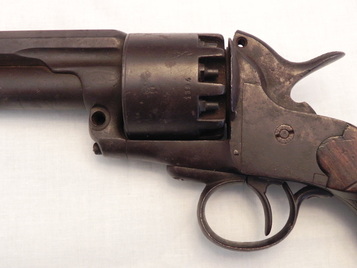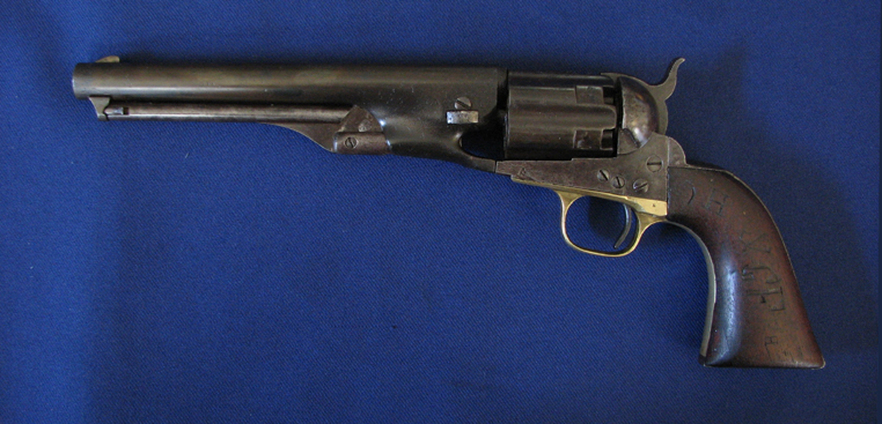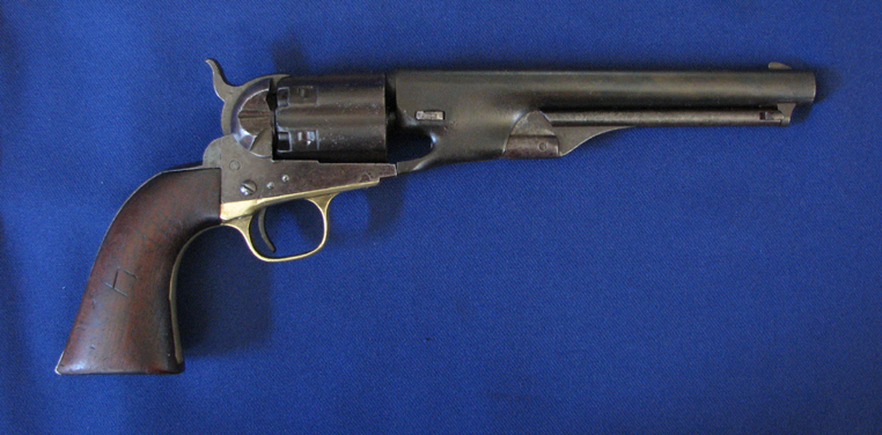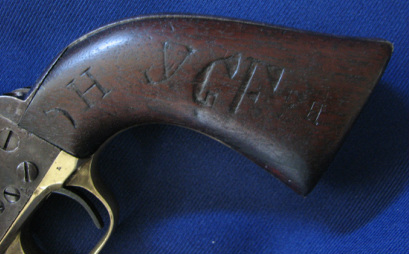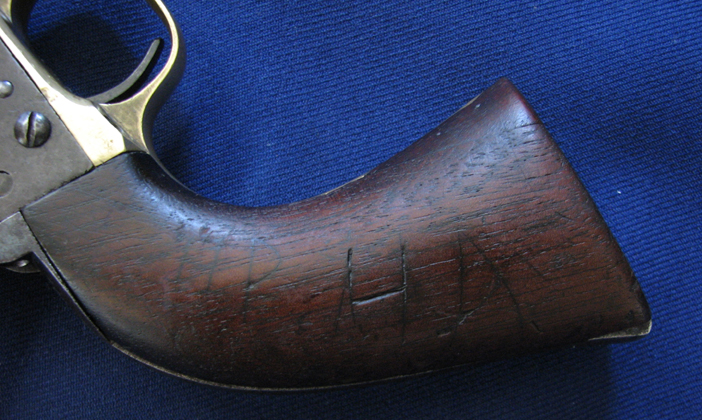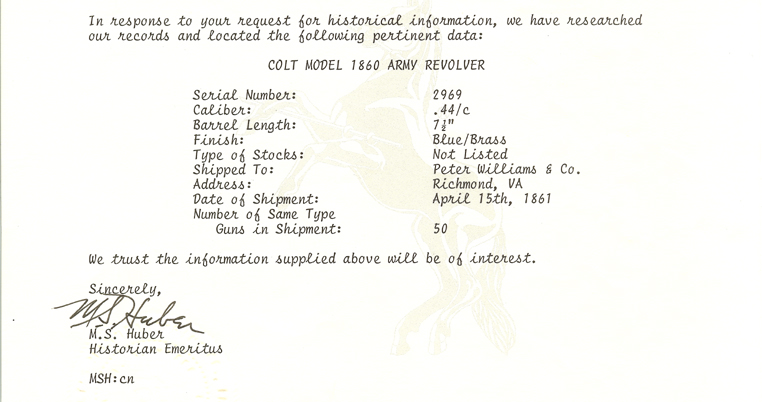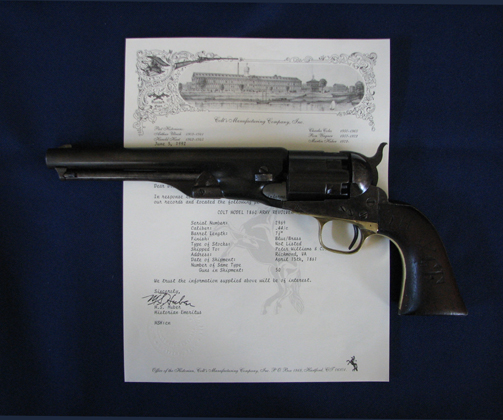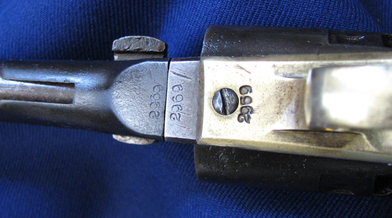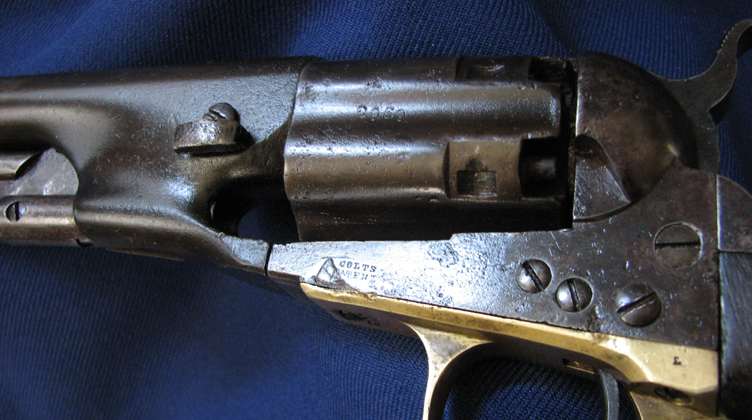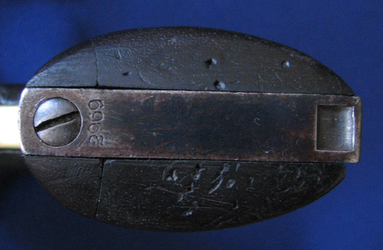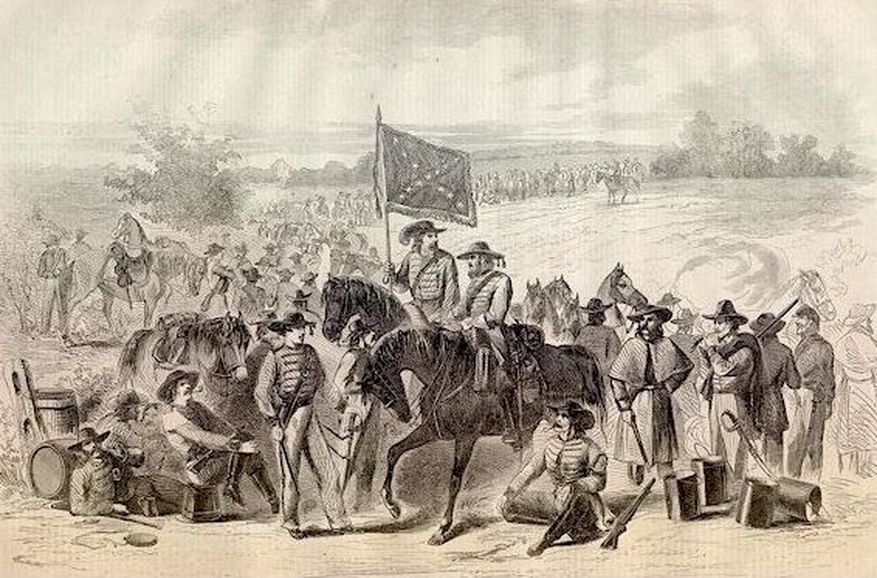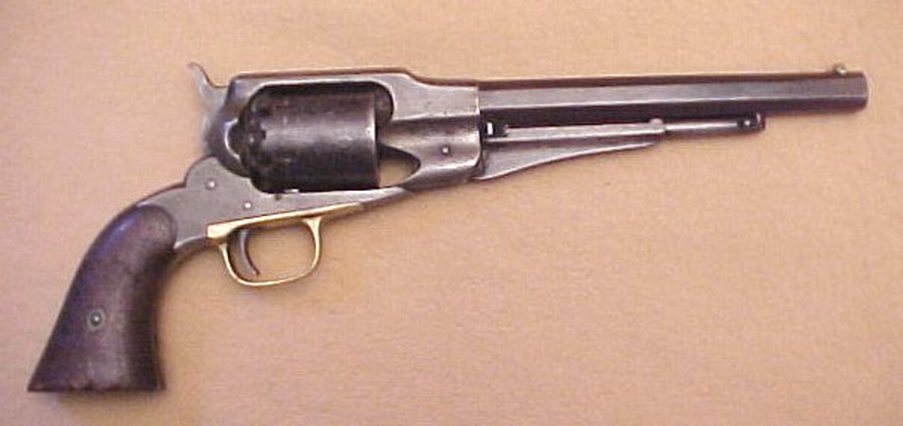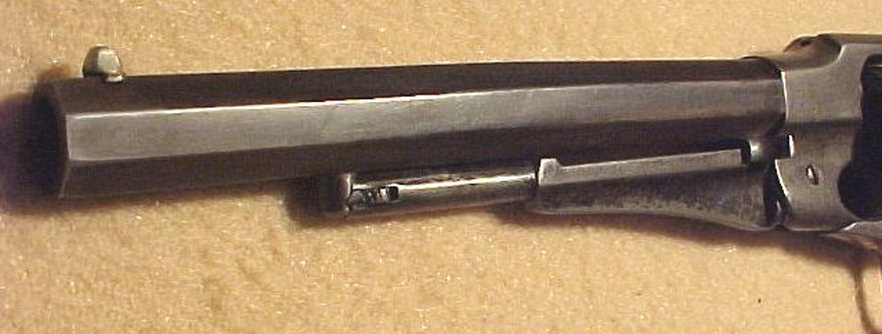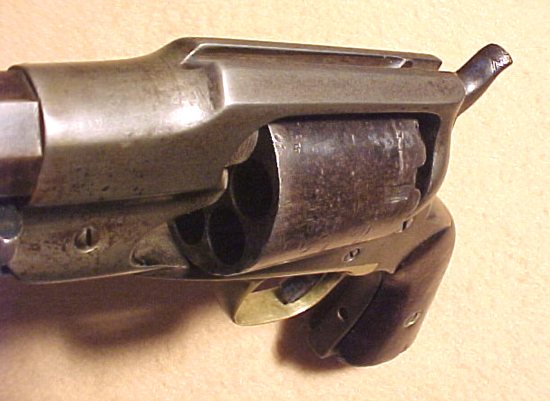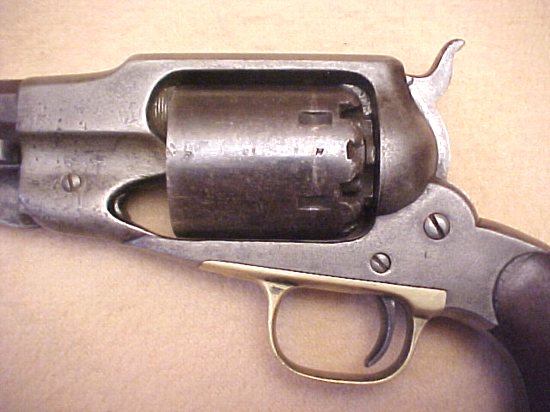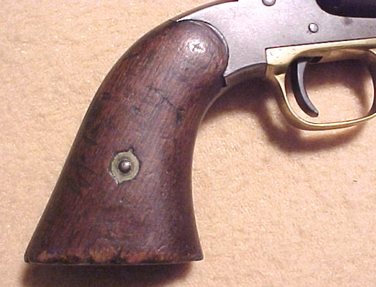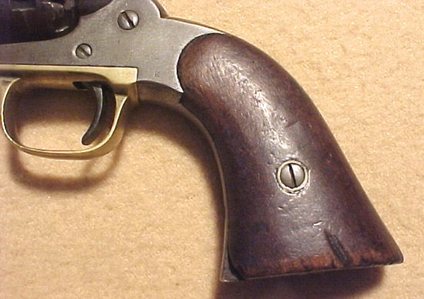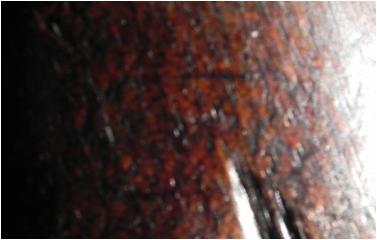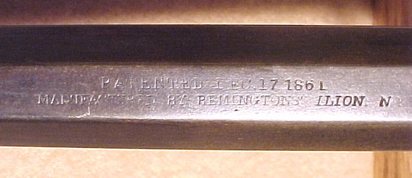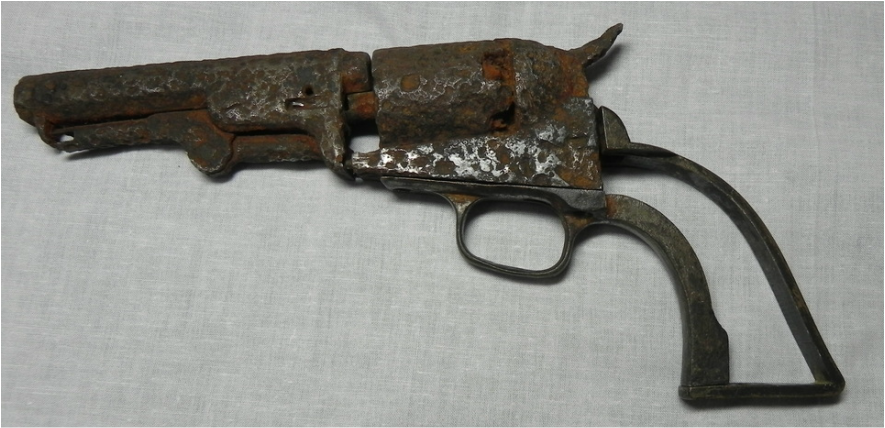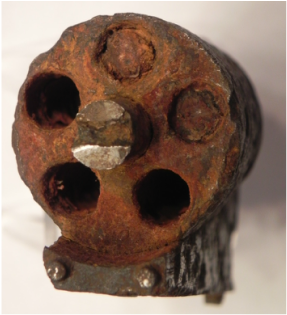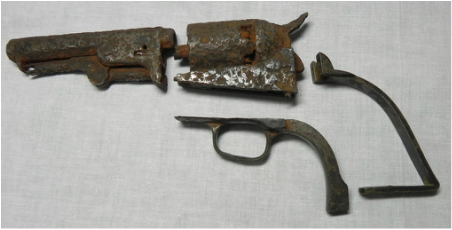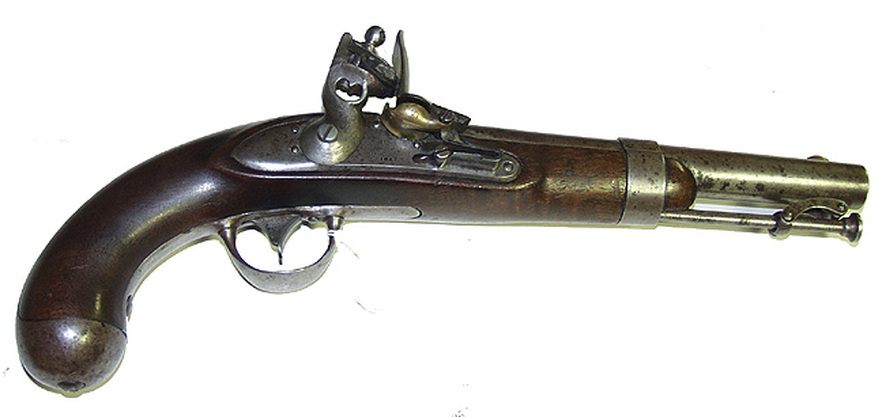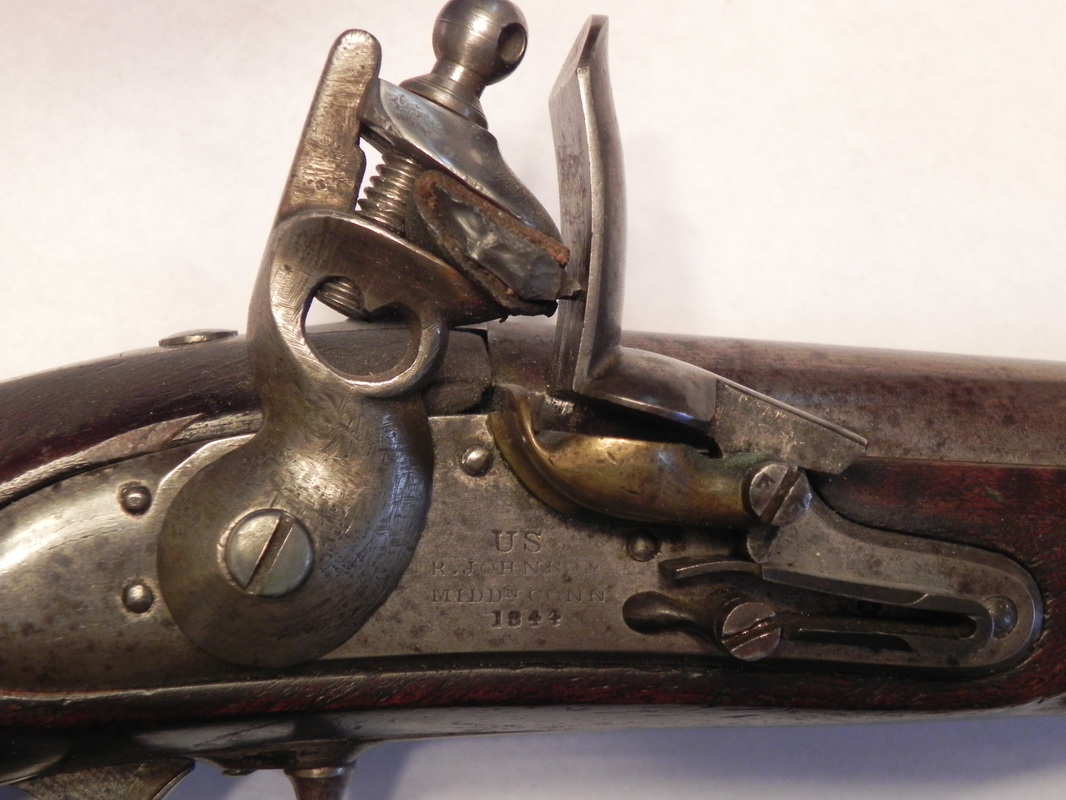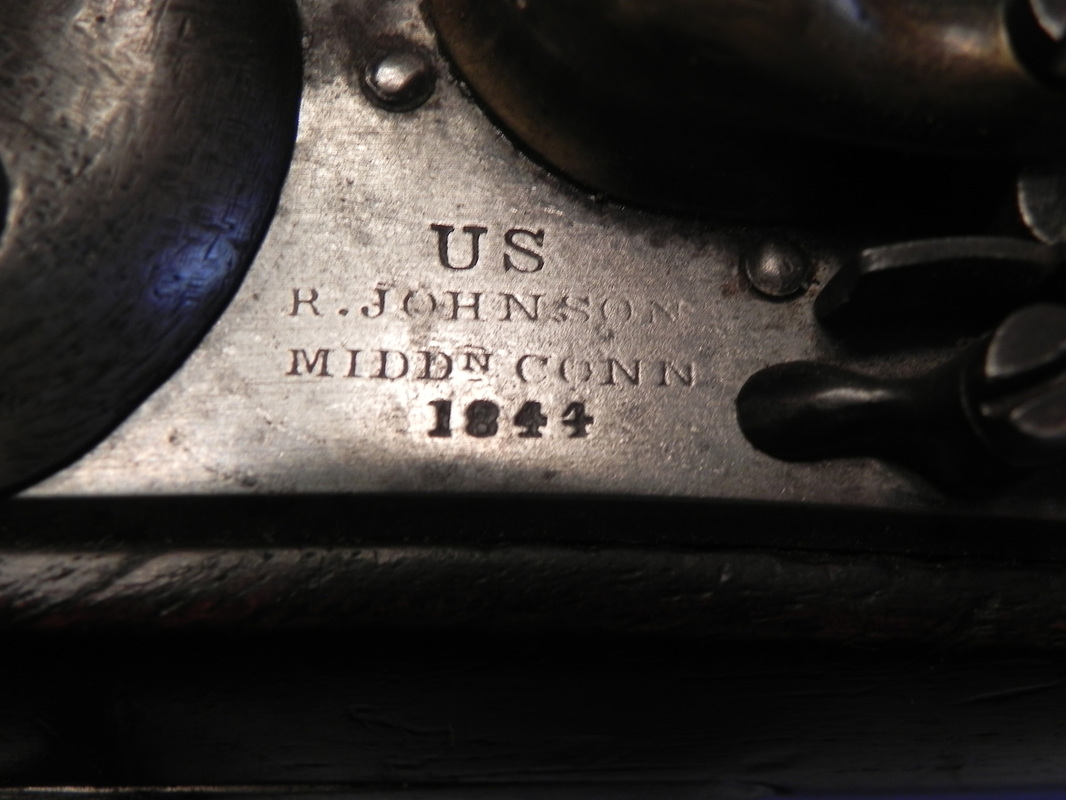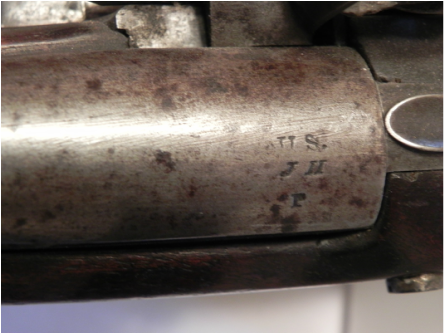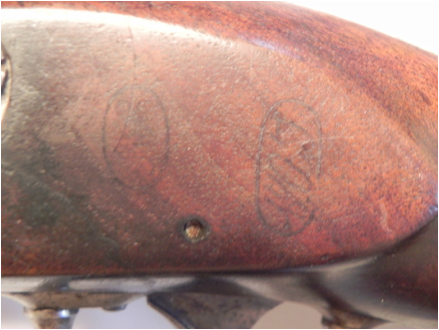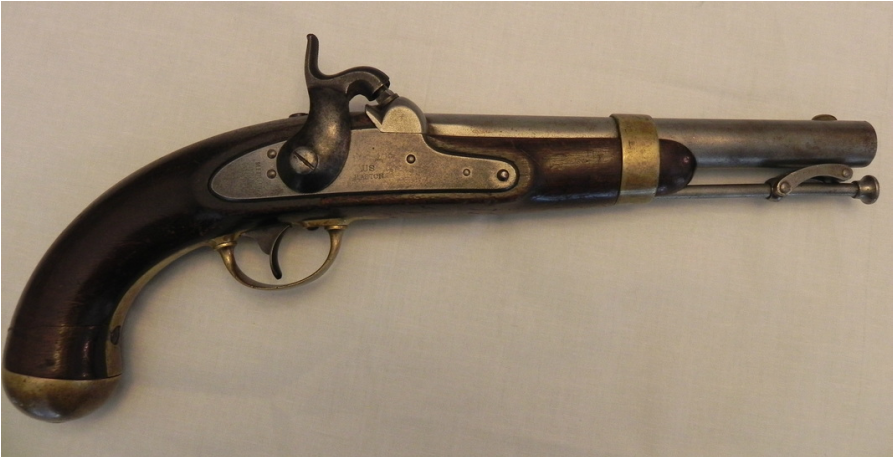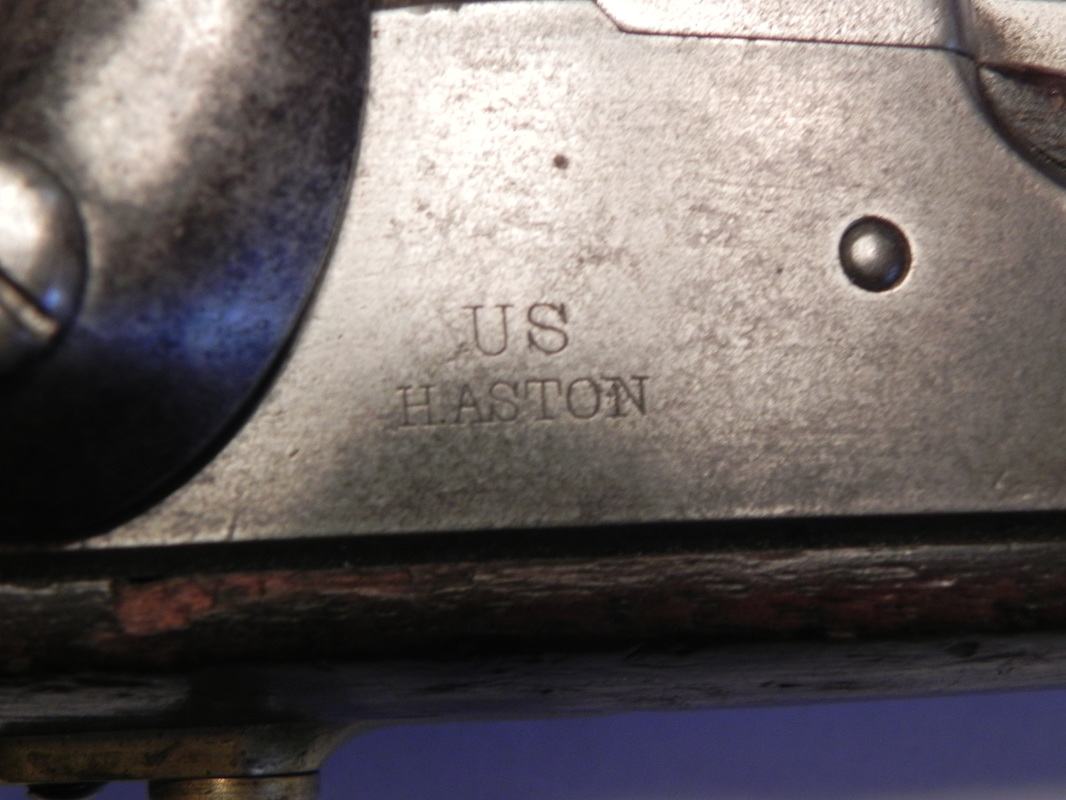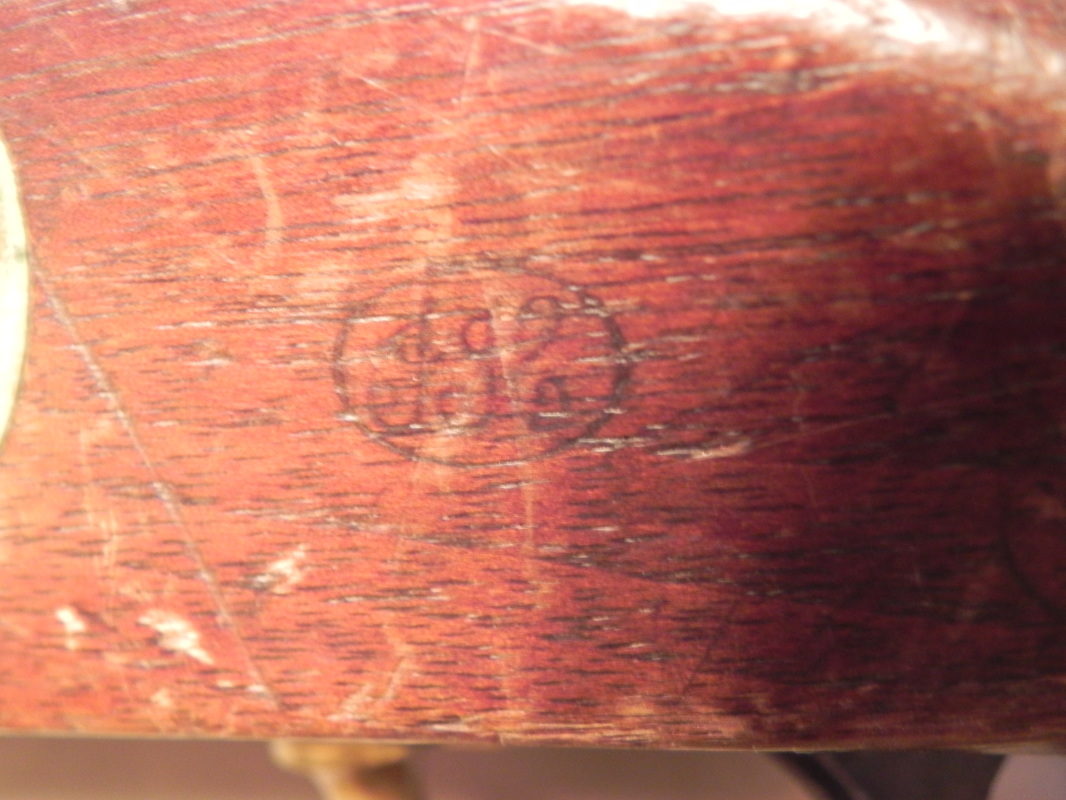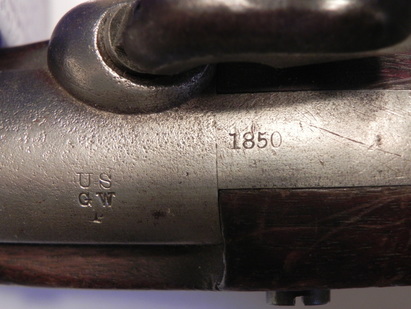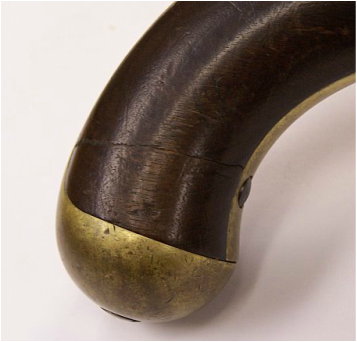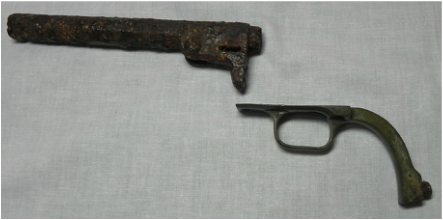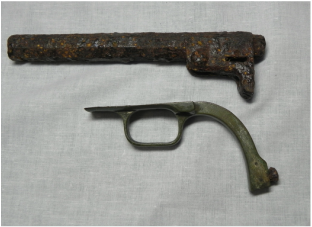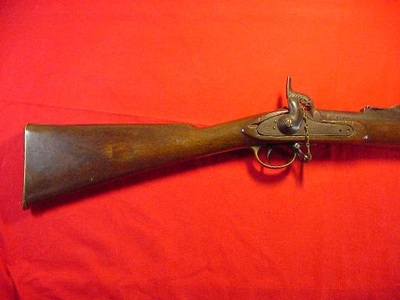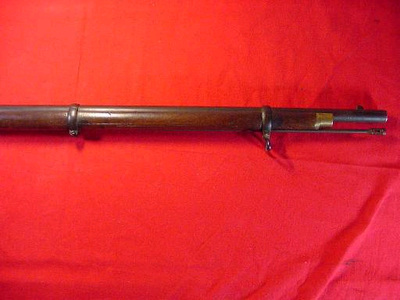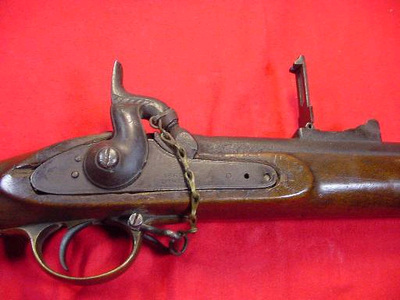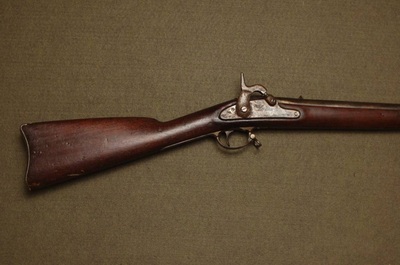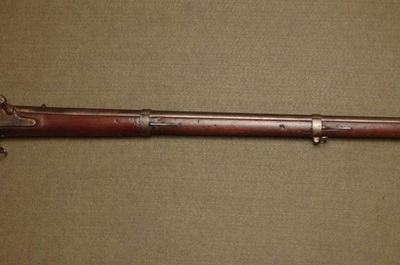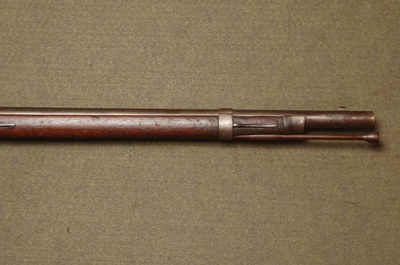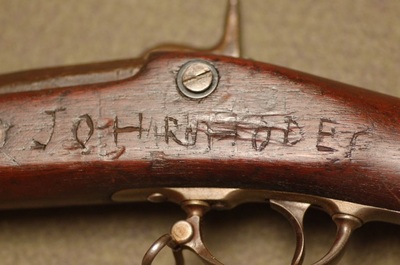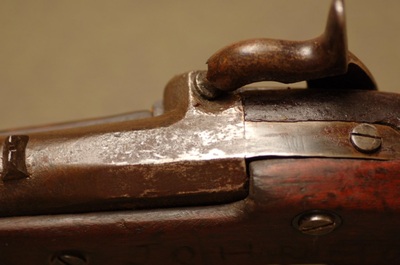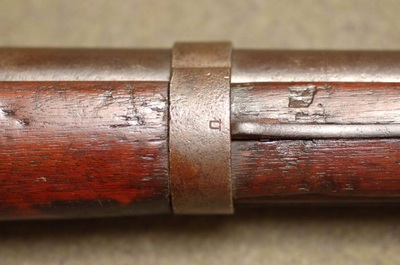Antique Small Arms
No matter how nice these may appear, antique firearms are made from 19th century iron and primitive steel alloys that were never designed to withstand the pressures of modern ammunition. Nor were they built with operational limits exceeding one hundred years past their date of manufacture. All antique firearms are collector's items only, and I do not endorse firing such weapons. No one should accept liability, expressed or implied, as to the shooting safety of any weapon similar to those shown below, regardless of condition.
RICHMOND CARBINE
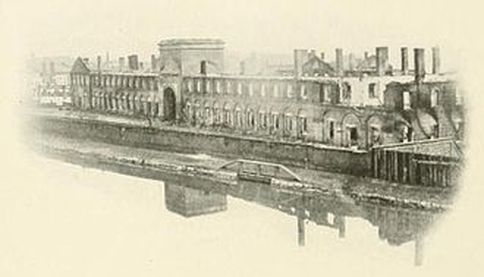 RUINS OF THE RICHMOND ARSENAL FOLLOWING IT DESTRUCTION IN APRIL 1865
RUINS OF THE RICHMOND ARSENAL FOLLOWING IT DESTRUCTION IN APRIL 1865
On April 18, 1861 the Virginia state forces captured Harper's Ferry. The captured stores and machinery were quickly removed to Richmond and set up in the old Virginia Armory. In late 1861, the Confederate States Government took over the facility and it was thereafter known as the "Richmond Armory". This facility was by far the most prolific maker of arms for the Confederacy. The rifles and muskets made at the Armory are the most widely recognized and sought after long arms of the Civil War. In 1862 the armory changed the method of attaching the nose cap from rivet to screw and the high hump lockplate was still in use as well as unmarked iron buttplates. In March, the Armory reduced the lock plate profile and made the last of the iron buttplates. This weapon is an early production Confederate manufactured Richmond .58 Caliber percussion Cavalry carbine with verbal history and graphic evidence of post war Native American use. The gun has an overall deep dark patina and light pitting, heavier in a few spots most notably on the bands, lock and breech. The lock markings are still visible, C.S. Richmond, Va. 1862. Rear sight, sling swivels (often found removed by the soldier) and fore end cap are missing but it retains the mounting base which is correctly tapped to accept the threaded assembly for the swivel and properly located on the stock behind the trigger guard.The barrel is milled to a "T" mortise. This was a Confederate innovation to better secure the rear sight. This carbine retains the original unique front sight. Mechanically fine. Although the wood is damaged there was obviously no tape primer cut-out under the lock. The ramrod is the original Richmond produced rod which itself is very rare. The gun carries family provenance that it was used by Indians in the American West and the stock exhibits several areas of extensive hand decoration as often encountered on Native used weapons. This is not a weapon for a collector looking for a pristine warehouse stored carbine. This was used.and used heavily before and after the war and is a 100% Richmond produced product and not one of the "put together" Confederate Richmond weapons that are all over the market. i strongly recommend Paul J. Davies book; " C.S. Armory Richmond".
Thumb area of, left to right, U.S. 1861 hammer, U.S 1855 hammer, typical CS Richmond hammer, and extremely crude CS Richmond hammer. Hammer on right belongs to pictured carbine.
Wood inside the center lockplate has been carved for a "mule foot", This is Confederate carving and is distinct from the Harpers Ferry groove on the left which was carved for the Maynard system. The picture on right is of the pictured carbine and shows the remains of the mule foot.
Left to right, A U.S. Springfield barrel, two CS Richmond musket barrels, and a CS Richmond carbine barel. Note the crudeness and uneven diameters of the Richmond barrels including the barrel of the pictured carbine on the right.
Head on views of, left to right, three Richmond ramrods and a Springfield ramrod. The comparative crudity of the Richmond examples is evident as is the image of the pictured carbine on the right.
Side views of, left to right, three Richmond ramrods and a Springfield ramrod. The comparative crudity of the Richmond examples is evident.
Front sites of, top to bottom, the U.S. Model 1855 rifle, the Richmond rifle, and the Richmond carbine. Note the fine milling of the 1855 rifle site in contrast to the pinched appearance of those of the Richmond Arsenal products.
From left to right- Model 1861 rear sight without steady pin; Richmond rear sight with steady pin; Richmond barrel with cut for steady pin; Image from above carbine.
58 Caliber Rifle Carbine sling swivel stud had the threads of an 1842 buttplate screw - Closeup is from the pictured carbine
The nose caps of, top to bottom, the Richmond rifle-musket, Richmond rifle, and the Richmond carbine. Note the increasing thickness of the nose cap to accommodate the increasing thickness of the stock between the ramrod channel and the barrel channel. The nose cap on the right was purchased separately but fits the pictured carbine quite nicely.
Complete and original Richmond long arms are almost impossible to find. At the time of assembly at the desperate Richmond Armory used whatever parts they could salvage including U.S. parts.. Over the years, as replacement parts were needed no one was concerned about retaining the Confederate purity.. Almost all of the carbines represented as Richmond Armory today are "put-togethers" with many U.S. replacements. These mismatched "marriages" may have been assembled in 1862 or yesterday. They may have been put together out of necessity during their time of use or put together to deceive an unsuspecting collector but there are many, many long arms being passed off as original. This one is a pure Richmond Armory carbine right down to the ramrod. I particularly like the bolster wear that can only happen from the corrosion from the percussion caps and black powder that corrode the metal that only occur after extensive loading and firing. This is not a pretty and pristine example; it is a example of a heavily used weapon used by a fighting rebel that no doubt participated in this historic event.
(Reference; "C.S. Armory Richmond" by Paul L. Davies; "Flayderman's Guide to Antique American Arms, 9th Addition", page 655; "Arms and Equipment of the Confederacy" by Time Life, page 45; "Civil War Collector's Encyclopedia, Vol. 1, Francis A. Lord" pages 208, 254; "Standard Catalog of Civil War Firearms" by John F. Graff, page 123; " Confederate Arms" by William A. Albaugh lll and Edward N. Simmons, page 80, 145, "Confederate Carbines & Muskatoons" by John M. Murphy, page 237)
SPENCER CARBINE
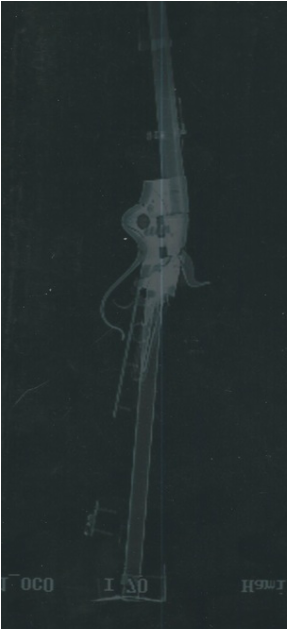
The Spencer was the primary repeating carbine and rifle of the Civil War. Most Spencers were issued in carbine form for the cavalry although rifles were also made for the infantry. Of the 144,500 Spencers made, 107,372 were acquired by the Federal Government during the war. It became the most popular of the carbines for cavalry use by the Union Army, and was widely used in the west after the Civil War.This relic Spencer carbine was purchased from Lawrence Christopher of Dalton, Ga. Mr. Christopher stated that the carbine was a battlefield pick-up from the battle of Nashville and that it was once part of large collection out of Chickamauga, Georgia. He stated that the collection was gathered from all over the south. The collection went "out west" for a few years until this item showed up in Lawrence's shop. Lawrence had it xrayed and it had no detectable bullets in the chamber. It is not easy to identify a weapon to a particular soldier or unit, but this is a really good candidate for the 19th Pennsylvania Volunteer Cavalry. The early serial number of 12381 puts it in the range match which is not a match but indicates the weapon's serial number is within the serial number range of identical weapons issued to the Civil War Regiment(s) listed. Therefore, a probability exists that the piece was issued to a soldier in the 19th Pennsylvania Vol Cavalry who fought at the battle of Nashville in December 15-16, 1865.
"Despite a series of defeats in the closing days of November, 1864, Confederate General John Bell Hood continued to drag his bloodied Army of Tennessee, approximately 30,000 strong, north towards Nashville. The city was protected by 55,000 men, which should have precluded further offensive operations, but Hood was determined and his situation was dire. Hood reached Nashville on December 2, 1865 and staked out a position south of the city, hoping to draw the Union forces into a costly attack. Ulysses S. Grant and Abraham Lincoln urged ranking general George Thomas to attack but he delayed for nearly two weeks, citing freezing weather and limited cavalry support. On December 15th, Thomas finally moved forward. The Union plan called for a demonstration on the Confederate right while the main assault struck a cluster of earthen redoubts on the Confederate left. The diversionary attack broke against artillery posted along present-day Battery Lane. To the west, fierce close-range combat erupted as Thomas’s men swept over the redoubts. That night, Hood retreated two miles further south. Thomas renewed the attack the next afternoon. After several hours of fighting, Brig. Gen. John McArthur broke through the Confederate left at Shy’s Hill. Hood ordered a hasty retreat south, and only a skillful rearguard action allowed his army to escape. The Union victory at Nashville shattered the Army of Tennessee and effectively ended the war in Tennessee."
Regardless of the story, this is an exceptional artifact, saw action and was the gun that a rebel soldier famously stated " the damn yankee rifles you could load on Sunday and fire all week". Spencer Carbines were prized by Yankee Horse Soldiers and Custer's men used them at the Battle of Gettysburg.
(Reference; "Flayderman's Guide to Antique American Firearms, 9th edition", page 633; "Spencer Repeating Firearms" by R. Marcot; Civil War Artifacts,; 'A Guide to The Historian" by Howard R. Crouch, page 86, 87; "The Illustrated History of American Civil War Relics" by Stephen W. Sylvia & J. O'Donnell, page 65; 'Warman's Civil War Weapons" by Graham Smith, page 110-113; "Standard Catalog of Civil War Firearms" by John F. Graff, page 171).
"Despite a series of defeats in the closing days of November, 1864, Confederate General John Bell Hood continued to drag his bloodied Army of Tennessee, approximately 30,000 strong, north towards Nashville. The city was protected by 55,000 men, which should have precluded further offensive operations, but Hood was determined and his situation was dire. Hood reached Nashville on December 2, 1865 and staked out a position south of the city, hoping to draw the Union forces into a costly attack. Ulysses S. Grant and Abraham Lincoln urged ranking general George Thomas to attack but he delayed for nearly two weeks, citing freezing weather and limited cavalry support. On December 15th, Thomas finally moved forward. The Union plan called for a demonstration on the Confederate right while the main assault struck a cluster of earthen redoubts on the Confederate left. The diversionary attack broke against artillery posted along present-day Battery Lane. To the west, fierce close-range combat erupted as Thomas’s men swept over the redoubts. That night, Hood retreated two miles further south. Thomas renewed the attack the next afternoon. After several hours of fighting, Brig. Gen. John McArthur broke through the Confederate left at Shy’s Hill. Hood ordered a hasty retreat south, and only a skillful rearguard action allowed his army to escape. The Union victory at Nashville shattered the Army of Tennessee and effectively ended the war in Tennessee."
Regardless of the story, this is an exceptional artifact, saw action and was the gun that a rebel soldier famously stated " the damn yankee rifles you could load on Sunday and fire all week". Spencer Carbines were prized by Yankee Horse Soldiers and Custer's men used them at the Battle of Gettysburg.
(Reference; "Flayderman's Guide to Antique American Firearms, 9th edition", page 633; "Spencer Repeating Firearms" by R. Marcot; Civil War Artifacts,; 'A Guide to The Historian" by Howard R. Crouch, page 86, 87; "The Illustrated History of American Civil War Relics" by Stephen W. Sylvia & J. O'Donnell, page 65; 'Warman's Civil War Weapons" by Graham Smith, page 110-113; "Standard Catalog of Civil War Firearms" by John F. Graff, page 171).
GRISWOLD REVOLVER
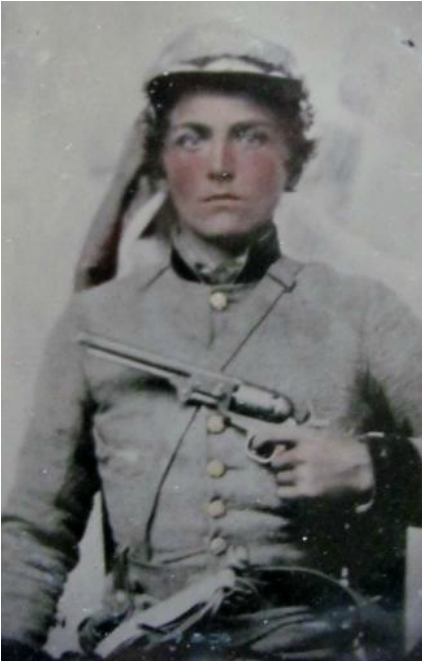
Operating as a cotton gin factory nine miles south of Macon, Georgia since 1835, Griswold and Gunnison was one of only three manufacturers who took advantage of the interest-free loans and generous contract terms the Confederate government offered to southern factories who would convert their facilities over to producing side arms for the Confederate Army. Of the three, Griswold and Gunnison was the only company that achieved any success as gun makers. In 1862, the Confederacy gave them the go-ahead to produce as many pistols as they could to supply troops that were carrying everything from Colt dragoons to antique flintlocks. The South never caught up to the North in sheer numbers of armaments, owing to a dire shortage of raw materials. The Griswold and Gunnison pistol was a near-exact copy of the .36 caliber percussion cap and ball 1851 Colt Navy revolver, except it had a brass frame instead of steel--due to the scarcity of metals in the south--and its barrel was round rather than octagonal. The factory made good quality weapons and produced nearly as many revolvers as all other Southern manufacturers combined but it was only able to produce about 3600 pieces before it was destroyed by Sherman during his 1864 march through Georgia. During the battle of Griswold station the pistol factory was destroyed by the 10th Ohio Cavalry and 3rd Kentucky Cavalry troops. Although production ceased in late 1864, the Confederacy continued to receive these revolvers as late as April 1865. Completed and uncompleted revolvers were likely moved before the plant was destroyed and were later assembled at another location. Two types of these revolvers were manufactured: a First Model and a Second Model of which the first model serial numbers run to about 1500.
The known lineage of this particular revolver traces back to Red Jackson of Jackson Arms, Dallas Texas. He was in the business of selling Antique Weapons from about 1940 to the 1980’s. It was purchased from Red Jackson by a Louisiana collector, Dr. Amile Ventry, and was in his collection for some time. It was eventfully brokered by David Condon who sold it to me. This piece has a nice patina, exhibits the fault lines, file marks, thick trigger guard, and crude workmanship. It has the unique trait of the Griswold in that the grips are angled in order to point the revolver more naturally to the target. The low serial number dates its manufacture between March and April of 1863.The revolver was well used and tuned, as the barrel was set back to tighten the gap between the cylinder and barrel. Some of the internal parts were replaced or repaired, probably at the time of use judging by the method of repair such as the cylinder lock bolt, the leg that disengages from the pawl on the hammer had collapsed so another leg was fashioned and pinned to the side, very well done. Judging from the fine pitting on both parts it was obviously a period repair. Also the trigger and bolt spring are two separate springs, each had broken on opposite sides and were stacked to make one. The cylinder pin was replaced at some time. Either the original broke or it was fashioned to set the barrel back on the frame to tighten the fit between the cylinder and barrel. There are the lovely and expected twist lines of the cylinder and barrel, caused by the twisted iron used in the manufacture of these revolvers. There is a straight grain visible on the loading lever, the catch can be slid out of its slot on the barrel. The barrel has six land and groove rifling, the bore exhibits a gain twist to the right. The front sight, a simple but effective brass cone, the rear sight is the V notch on front of hammer. The grips are smoothly worn, shrunk and repaired but are original to the gun.They were numbered in the cut-out for back strap in red pencil, appears to be “94”. The grips show evidence of being repaired on the inside, when disassembled the center section that connects the two sides, looks to have twisted and cracked. Probably from the wood not being completely cured when the grips were fitted to the revolver. The serial numbers “794” match on the frame, barrel, loading lever, cylinder, trigger guard and back strap. The hammer has “9” or “6” stamped on the side. There are several parts marked with a backward “11” or two dashes, considered as the cryptic marks, they are located on the barrel behind the loading lever catch, the side flats of the trigger guard and back strap, and rear face of frame. These first models saw the hardest use early in the war and this is a good example of Griswold’s manufacture.
(Reference; "Confederate Revolvers" by William A. Gary, page 2; "Flayderman's Guide to Antique American Arms, 9th Addition", page 642; "Collecting The Confederacy" by Shannon Pritchard, page 130; "Arms and Equipment of the Confederacy" by Time-Life, page 59; "Civil War Artifacts A Guide to The Historian" by Howard Crouch, page 207; " Confederate Arms" by William A. Albaugh lll and Edward N. Simmons, pages 4-11; "Confederate Handguns" by William A. Albaugh III, Hugh Benet, Jr.and Edward N. Simmons, pages 23-38; "Civil War Relics from Georgia" by Celeste C. Topper and David Topper, page 96-97; "The Confederate Brass-Framed Colt & Whitney" by William A. Albaugh III, pages 1-26).
EARLY FOUR SCREW 1860 COLT ARMY
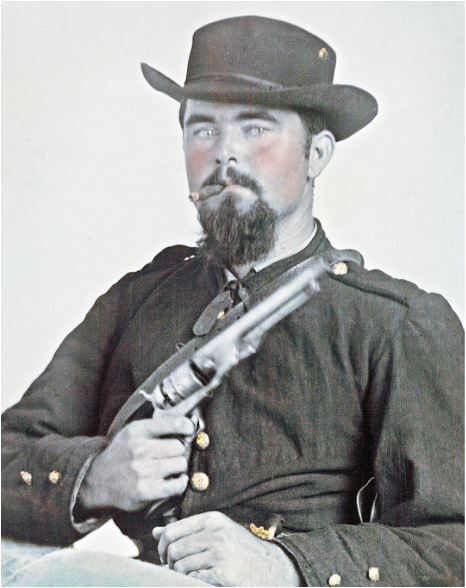
The Colt Model 1860 Army revolver was manufactured from 1860 through 1873 with a total production of more than 200,000. It was a six-shot, .44 caliber revolver and the primary handgun used by Union troops during the Civil War because of its reliability. This is an early four-screw colt model 1860 army .44 caliber percussion revolver that has a very low serial number of 16352.The revolver was manufactured by Colt Firearms, Hartford Connecticut and has a very desirable production date of 1861 and like most of these early war issues clearly saw four years worth of combat in the Civil War. These early 4-screw frames were made to accommodate a special detachable wooden shoulder stock specifically for the Cavalry. These stocks were very unpopular so there were very few made. I have a Colt letter on this revolver. It was sold to the United States War Department and shipped to Maj. R.H.K. Whiteley at the New York War Arsenal, Governor's Island, New York on November 25, 1861. It was one of a shipment of 500. All the serial numbers match except for the wedge. Barrel address is clear but the cylinder scene is all but gone with only the slightest remnants left. Grips are original to the gun but has a wiggle due to a minor internal crack.This old veteran shows the signs of battle but is in not bad shape for the service it saw and it works well mechanically. With a jewelers loop you can make out the faint remains of the military cartouche. This cartouche along with the small sub-inspector stamp let us know that this is a military model instead of a civilian gun. This is the classic weapon of the Civil War and no doubt saw the fighting from the very beginning.
(Reference; "Flayderman's Guide to Antique American Arms, 9th Addition", page 94; "Arms and Equipment of the Confederacy" by Time-Life Books, page 52; 'Warman's Civil War Weapons" by Graham Smith, page 28; "Standard Catalog of Civil War Firearms" by John F. Graff, page 200; " Standard Catalog of Colt Firearms" by Rick Sapp, page 48; " Arms and Equipment of the Union" by Time-Life Books, page 64; "Civil War Pistols of the Union" by John D. McAulay, page 34-40)
(Reference; "Flayderman's Guide to Antique American Arms, 9th Addition", page 94; "Arms and Equipment of the Confederacy" by Time-Life Books, page 52; 'Warman's Civil War Weapons" by Graham Smith, page 28; "Standard Catalog of Civil War Firearms" by John F. Graff, page 200; " Standard Catalog of Colt Firearms" by Rick Sapp, page 48; " Arms and Equipment of the Union" by Time-Life Books, page 64; "Civil War Pistols of the Union" by John D. McAulay, page 34-40)
HARTFORD COLT NAVY
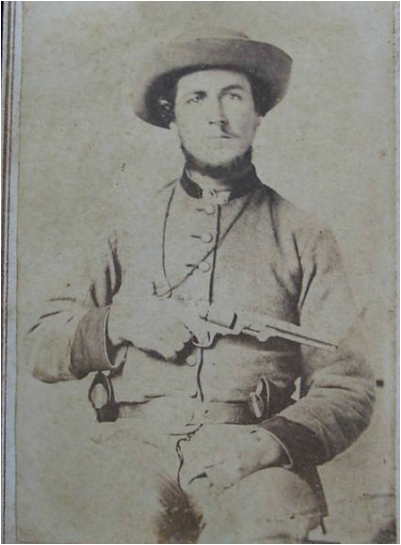 Colt Navy
Colt Navy
A solid, very good condition Colt 1851 Navy. It's the fourth model with the large brass trigger guard, 36 caliber, 7 1/2 inch octagon barrel and desirable Hartford address. The gun has matching serial numbers of 92584 except for the wedge which is a numbered colt wedge. The serial number on this colt places its production at the end of 1859. It still has traces of the cylinder scene. The action is crisp and tight. Grips have a little original varnish and have smooth edges with no wood missing. Traces of silver remain around the trigger guard. Overall grey gun with clear address and serial numbers. I am partial to these Colt Navies because they are so much part of the Confederate accouterments. The Colt Navy was Nathen Bedford Forrest's revolver of choice.The majority of these Hartford address Navies in the 90,000 - 100,000 serial range
(and the fluted Colts) were bought by the various Southern states in 1860 following Lincoln's election, as they armed up in preparation for war. New York was a hot bed of abolitionist sentiment and the Colt 1851 Navy was very popular in the South, especially in 1860.The ever industrious Sam Colt quietly changed his New York barrel address and substituted the Hartford, CT barrel address, so as not to offend his Southern clientele. As soon as the Civil War began, he very quickly reverted to the New York address.
(Reference; "Flayderman's Guide to Antique American Arms, 9th Addition", page 89; "Arms and Equipment of the Confederacy" by Time-Life Books, page 53; " Arms and Equipment of the Union" by Time-Life Books, page 65; 'Warman's Civil War Weapons" by Graham Smith, page 24; "Standard Catalog of Civil War Firearms" by John F. Graff, page 196, 197; " Standard Catalog of Colt Firearms" by Rick Sapp, page 45; "Civil War Pistols of the Union" by John D. McAulay, page 28-34; "'51 Colt Navies" by Nathan L. Swaze)
(and the fluted Colts) were bought by the various Southern states in 1860 following Lincoln's election, as they armed up in preparation for war. New York was a hot bed of abolitionist sentiment and the Colt 1851 Navy was very popular in the South, especially in 1860.The ever industrious Sam Colt quietly changed his New York barrel address and substituted the Hartford, CT barrel address, so as not to offend his Southern clientele. As soon as the Civil War began, he very quickly reverted to the New York address.
(Reference; "Flayderman's Guide to Antique American Arms, 9th Addition", page 89; "Arms and Equipment of the Confederacy" by Time-Life Books, page 53; " Arms and Equipment of the Union" by Time-Life Books, page 65; 'Warman's Civil War Weapons" by Graham Smith, page 24; "Standard Catalog of Civil War Firearms" by John F. Graff, page 196, 197; " Standard Catalog of Colt Firearms" by Rick Sapp, page 45; "Civil War Pistols of the Union" by John D. McAulay, page 28-34; "'51 Colt Navies" by Nathan L. Swaze)
LeMAT REVOLVER
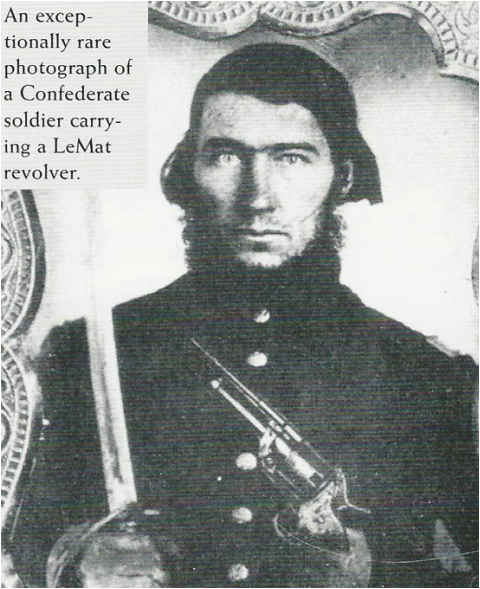
"In the Black, attic condition" second model Confederate LeMat. This revolver is hands down the most romantic of all Confederate used handguns and has the unique LeMat combination of a conventional .42 caliber nine shot and 16 gauge percussion revolver. This has a desirable serial number 1394. In Wiley Sword’s text "Firepower From Abroad" he notes that probably only the first 1450 LeMats made it to the Confederacy in time for the Gettysburg Campaign.If that is the case this would have been one of the last shipments to make it through blockade for the major 1863 and 1864 Campaigns of the Civil War. It has the clear barrel address "Col. LeMat Bte s.g.d.g. Paris". It is numbered on the barrel (with LM proof), cylinder, frame and trigger. All metal is dark and smooth. Checkered wood grip with rich patina. Mechanically fine, excellent bores. Missing the loading lever assembly and the shotgun striker on the face of the hammer. The old timers tell me that it was common for soldiers to take off the loading levers to better facilitate taking the gun in and out of the holster, and some that have handled lots of LeMats think that they took them off out of frustration over the fact that the LeMat never had a proper lever latching system. Regardless, by the wear and patina the loading lever has been missing in action for many years. The LeMat is classified and collected as a confederate handgun as it was both purchased and imported by the Confederate government during the Civil War and privately purchased by many officers for their personal use. It's estimated that total production is fewer than 2,900 revolvers and about 1500 of these firearms made it into Confederate service. The LeMat revolver was developed by Dr. Jean LeMat of New Orleans, Louisiana, and patented in 1856. This revolver was manufactured in Paris, France . These were highly coveted by Confederate officers and were the choice of many including Major P.G.T. Beauregard (he was a partner in the firm), Major Generals Braxton Bragg, J.E.B. Stuart (who carried a LeMat when he was mortally wounded at the battle of Yellow Tavern, Virginia in 1864), General John Lawson Lewis of Louisiana, South Carolina surgeon T.B. Minnesinger, Captain James Lemon of Georgia, Captain Albert Hervey of the Texas Cavalry and Major Henry Wirz, commander of Anderson prison. In Charles Frazier’s 1997 National Book Awards winning Cold Mountain the book’s hero Inman proudly owned a pair of LeMat revolvers.
(Reference; " The Confederate LeMat Revolver" by Doug Adams; "Confederate Revolvers" by William A. Gary, page 116; "Flayderman's Guide to Antique American Arms, 9th Addition", page 643; "Collecting The Confederacy" by Shannon Pritchard, page 132; Civil War Collector's Encyclopedia, Vol. 1, Francis A. Lord page 208; "Arms and Equipment of the Confederacy" by Time-Life Books, page 57; "Civil War Artifacts A Guide to The Historian" by Howard Crouch, page 212; " Confederate Arms" by William A. Albaugh lll and Edward N. Simmons, page 32; "Civil War Collector's Encyclopedia", Volume I, by Francis A. Lord, page 208; "Confederate Handguns" by William A. Albaugh III, Hugh Benet, Jr. and Edward N. Simmons, pages 81-124;.The English Connection - Arms, Material and Support Furnished to the Confederate States of America by Great Britain" By Russ A. Pritchard Jr. & C.A. Huey with Mike Nichols, Tim Prince & Dean Thomas)
FLUTED COLT "SHIPPED SOUTH"
- THE FATE OF THIS SHIPMENT WAS DETAILED BY THIS ARTICLE POSTED BY THE ALEXANDRIA GAZETTE ON APRIL 24, 1861
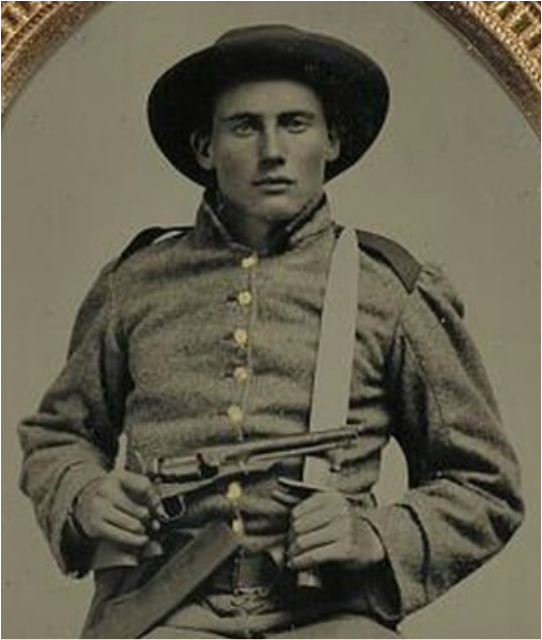
The Model 1860 Colt Army revolver was one of the most desirable Civil War handguns. Accurate, reliable, lightweight, and powerful, Sam Colt's design was state of the art in handgun technology and set the bar for all handguns designed after it. These early .44 percussion "New Army" revolvers were the result of experimentation to reduce the size and weight of the .44 Dragoon revolvers which weighed in at 4 pounds 2 ounces. The Dragoon was introduced in 1848 as an improvement on the massive Walker Colt. Colt actually called the new model the "Cavalry Model" with a weight of 2 pounds 8 1/2 ounces. He even created a quick release stock so it could be used as a carbine.
This model had some early production issues and it was a southern gun dealer named H D. Norton & Brothers of San Antonio that brought forward the fact that the new "fluted" cylinders had a propensity to burst when fired due to the thinness of the metal between the chambers. Attempts to fix the problems with the fluted cylinders failed so the fluted cylinders were replaced by the original rebated round cylinder. It is believed that only about 4,000 revolvers with the fluted cylinders were produced ranging from serial numbers 3 to 8,000 and many were returned for the replacement of the cylinder. During the early production of the New Model army, Colt also changed their barrel address from the "Hartford" address that had been adopted in 1857 to the "New York" address that appeared sometime during 1861. The early fluted colt with the 71/2 " inch barrel also gave way to the 8" barrel after the first 1000 of the "new colt" production because the ordinance department preferred the 8" barrel. This makes early production with "pre-tinkering" fluted cylinders and 71/2" Hartford address barrels extremely scarce, even more so as many of the early revolvers were sent south where they saw hard use for the full length of the war.
At this time the southern states, due to the election of Abraham Lincoln and the prospect of war, began purchasing all of these weapons they could find. In the five months between Lincoln's election and the firing on Fort Sumter on April 15, 1861, some 2,230 New Army revolvers were shipped to southern states and southern arms dealers. Some of the biggest orders went to Kittredge & Folson of New Orleans (1000), the state of Georgia (300) and Peter Williams & Company of Richmond (500). Several days before Virginia seceded from the Union a batch of 372 of these revolvers was shipped to Williams, Peters, & Co. in Richmond, Virginia. Other batches brought the total to 500 guns. By the time the weapons reached their destination, Virginia was a Confederate state and the guns were seized (on Sunday at Adams Express office) by the new government for distribution to Confederate troops of the 1st. Virginia Cavalry. Whether this order by a private Richmond gun dealer and the subsequent "seizing" were part of a ruse to obtain modern handguns for the South or simply coincidental remains uncertain. What is certain is that they were made by America's premier gun maker, bought by a Southern firm, seized by Confederate agents, issued to Confederate troops, and used to defend the South.
This colt is accompanied by a Colt factory letter stating that it was shipped to Peter Williams & Co., Richmond, V.A., April 15,1861. As stated above this weapon was included in the last shipment to the South and was one of 500 shipped after the firing on Fort Sumter. This revolver would have been issued to the 1st. Virginia Cavalry after the State Authorities seized the 500 Army Revolvers. All of these revolvers saw good service throughout the war and the gun is a solid old veteran with moderate wear, a few dents and some pin prick rust damage. It has all matching numbers to include the barrel, frame, trigger guard, back strap, cylinder, cylinder pin and wedge. A close examination of the back strap channel in the grips also reveals a partial serial number in ink, which appears to match. It has good barrel markings. There are a whole lot of different initials in the grips. Confederate soldiers often carved their initials into the grips of the guns they were issued. Remarkably there are at least six different sets of initials on this gun. It, no doubt, was issued to six or more different Confederate soldiers. The gun still has good action, rifling in the bore and decent grips. The toe of each grip has been repaired. The repairs look to be very old. A remarkable, hard to find Southern Colt that could tell lots of stories.
This model had some early production issues and it was a southern gun dealer named H D. Norton & Brothers of San Antonio that brought forward the fact that the new "fluted" cylinders had a propensity to burst when fired due to the thinness of the metal between the chambers. Attempts to fix the problems with the fluted cylinders failed so the fluted cylinders were replaced by the original rebated round cylinder. It is believed that only about 4,000 revolvers with the fluted cylinders were produced ranging from serial numbers 3 to 8,000 and many were returned for the replacement of the cylinder. During the early production of the New Model army, Colt also changed their barrel address from the "Hartford" address that had been adopted in 1857 to the "New York" address that appeared sometime during 1861. The early fluted colt with the 71/2 " inch barrel also gave way to the 8" barrel after the first 1000 of the "new colt" production because the ordinance department preferred the 8" barrel. This makes early production with "pre-tinkering" fluted cylinders and 71/2" Hartford address barrels extremely scarce, even more so as many of the early revolvers were sent south where they saw hard use for the full length of the war.
At this time the southern states, due to the election of Abraham Lincoln and the prospect of war, began purchasing all of these weapons they could find. In the five months between Lincoln's election and the firing on Fort Sumter on April 15, 1861, some 2,230 New Army revolvers were shipped to southern states and southern arms dealers. Some of the biggest orders went to Kittredge & Folson of New Orleans (1000), the state of Georgia (300) and Peter Williams & Company of Richmond (500). Several days before Virginia seceded from the Union a batch of 372 of these revolvers was shipped to Williams, Peters, & Co. in Richmond, Virginia. Other batches brought the total to 500 guns. By the time the weapons reached their destination, Virginia was a Confederate state and the guns were seized (on Sunday at Adams Express office) by the new government for distribution to Confederate troops of the 1st. Virginia Cavalry. Whether this order by a private Richmond gun dealer and the subsequent "seizing" were part of a ruse to obtain modern handguns for the South or simply coincidental remains uncertain. What is certain is that they were made by America's premier gun maker, bought by a Southern firm, seized by Confederate agents, issued to Confederate troops, and used to defend the South.
This colt is accompanied by a Colt factory letter stating that it was shipped to Peter Williams & Co., Richmond, V.A., April 15,1861. As stated above this weapon was included in the last shipment to the South and was one of 500 shipped after the firing on Fort Sumter. This revolver would have been issued to the 1st. Virginia Cavalry after the State Authorities seized the 500 Army Revolvers. All of these revolvers saw good service throughout the war and the gun is a solid old veteran with moderate wear, a few dents and some pin prick rust damage. It has all matching numbers to include the barrel, frame, trigger guard, back strap, cylinder, cylinder pin and wedge. A close examination of the back strap channel in the grips also reveals a partial serial number in ink, which appears to match. It has good barrel markings. There are a whole lot of different initials in the grips. Confederate soldiers often carved their initials into the grips of the guns they were issued. Remarkably there are at least six different sets of initials on this gun. It, no doubt, was issued to six or more different Confederate soldiers. The gun still has good action, rifling in the bore and decent grips. The toe of each grip has been repaired. The repairs look to be very old. A remarkable, hard to find Southern Colt that could tell lots of stories.
The 1st Virginia Cavalry began the war as a group of independent companies of horse from the Shenandoah Valley, organized into a regiment by J.E.B. Stuart, who later became a Major General. It consisted initially of 12 companies (A - M), and completed organization July 16, 1861One of the most famous Confederate cavalry regiments, the 1st Virginia was led by such intrepid leaders as J.E.B. Stuart, "Fitz" Lee, and "Grumble" Jones.
The 1st distinguished itself in in many actions, including but not limited to, the Shenandoah Valley in 1861, at Bull Run, in Stuart's ride around McClellan, at Catlett's Station, Brandy Station, Kelly's Ford, Gettysburg, the Buckland "Races", Todd's Tavern, Spotsylvania Court House, Yellow Tavern, Haw's Shop, Nance's Shop, Cold Harbor, Reams' Station, Front Royal, Winchester, Waynesboro, Five Forks, and Appomattox Court House.
The regiment fought in over two hundred battles and skirmishes. From its ranks sprang such renowned cavalry leaders as John Singleton Mosby ( later to become the leader of Mosby's partisan rangers), Ridgely Brown, and Gustavus W. Dorsey. Despite heavy casualties, the 1st maintained its high morale and elan to the bitter end. Escaping at Appomattox Court House, the regiment marched on to Lynchburg before disbanding on April 11, 1865.
The 1st distinguished itself in in many actions, including but not limited to, the Shenandoah Valley in 1861, at Bull Run, in Stuart's ride around McClellan, at Catlett's Station, Brandy Station, Kelly's Ford, Gettysburg, the Buckland "Races", Todd's Tavern, Spotsylvania Court House, Yellow Tavern, Haw's Shop, Nance's Shop, Cold Harbor, Reams' Station, Front Royal, Winchester, Waynesboro, Five Forks, and Appomattox Court House.
The regiment fought in over two hundred battles and skirmishes. From its ranks sprang such renowned cavalry leaders as John Singleton Mosby ( later to become the leader of Mosby's partisan rangers), Ridgely Brown, and Gustavus W. Dorsey. Despite heavy casualties, the 1st maintained its high morale and elan to the bitter end. Escaping at Appomattox Court House, the regiment marched on to Lynchburg before disbanding on April 11, 1865.
(Reference; "Flayderman's Guide to Antique American Arms, 9th Addition", page 94; 'Warman's Civil War Weapons" by Graham Smith, page 27; "Standard Catalog of Civil War Firearms" by John F. Graff, page 199; " Standard Catalog of Colt Firearms" by Rick Sapp, page 50; "Civil War Pistols of the Union" by John D. McAulay, pages 34-40)
MODEL 1861 REMINGTON ARMY
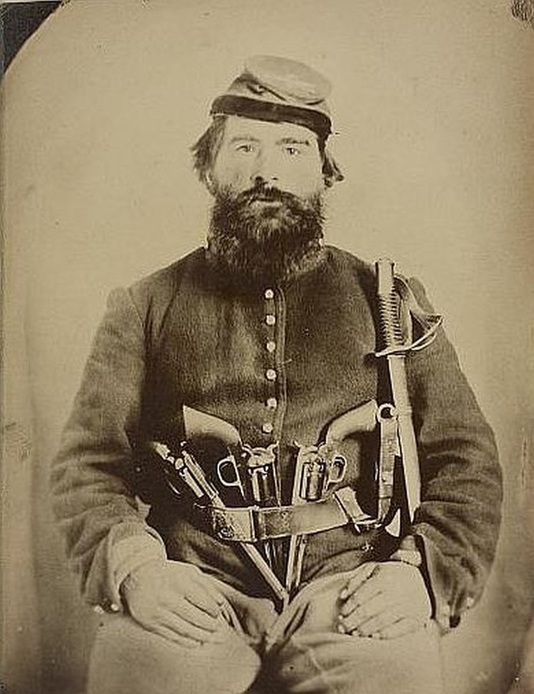
This is a Remington 1861 Army revolver and is often referred to as the "Old Model Army". The Remington Army was the second most used Civil War revolver and widely regarded as superior to the Colt. The M-1861 was intended to be an improvement on the older Beals Model Army revolvers that Remington had produced from 1858 to 1862. Only 850 of the .44 “Army” caliber Beals revolvers were purchased by the Ordnance Department and they are very rare guns today. The M-1861 or “Old Army” percussion revolver included the improvements covered under William Elliott’s patent #33,932 of December 17, 1861. This patent allowed the cylinder arbor pin to be removed from the frame, freeing the cylinder, without lowering the loading lever. Other improvements included a redesigned frame that left the barrel threads exposed at the rear of the frame. This reduced the amount of metal used in the frame, saving cost and weight. Remington received a contract on July 13, 1862 for 20,000 of their new M-1861 44 Army revolvers. During the next 6 months, Remington delivered a total of 4,902 of their M-1861 44 caliber revolvers to the Ordnance Department. In use, the “improvements” covered under Elliott’s patent were not really improvements. The grooved loading lever that allowed the removal of the arbor pin without lowering it also allowed the pin to move forward under the inertia of recoil. When this happened, the revolver became locked up and non-functional. As a result, most of the M-1861 revolvers were returned to the Remington factory where the channel was blocked to prevent the movement of the pin, or the loading lever was replaced with the old pattern, solid Beals type lever. Other complaints revolved around the lack of safety notches on the cylinder. As a result, the M-1861 “Old Army” was redesigned as the “New Model Army” (aka M-1863) and all deliveries under US Ordnance contracts from January 1863 onward were of the new version of the revolver. Even the 15,098 outstanding revolvers from the June of 1862 contract, that were delivered in 1863, were “New Model” instead of “Old Model” Army revolver. The development of the “New Model” occurred concurrently with the production of “Old Model” revolvers. As production continued into the later part of 1862, M-1861 Old Model revolvers began to emerge from Ilion with safety notches on the rear of the cylinder and loading levers that blocked the cylinder arbor pin. All of the Remington “army” caliber revolvers were serial numbered in the same range, starting with the Beals series, and through the M-1861 and M-1863 variants. As production of the models was sometimes concurrent (Beals & M-1861s simultaneously, and M-1861s and M-1863 simultaneously as well) it is difficult to separate the models by serial number except within ranges. Beals models were produced in the 1-3000 range, M-1861s in the 3,000-22,000 range and M-1863s in the 15,000 to the end of production (about 135,000). Early manufacture of the M-1861s used the Beals type frame with concealed barrel threads at the breach. About mid-production the exposed barrel thread frame was introduced. On late manufactured specimens safety notches were introduced at the rear of the cylinder. During the course of the American Civil War, Remington would deliver some 115,557 .44 revolvers to the US Ordnance Department. However, only 850 would be the oldest Beals pattern guns (0.7%) and 4,902 would be the M-1861 “Old Model” Army (4%). The balance would all be the M-1861 “New Model” revolvers. Eventually more than 70 US cavalry regiments would be armed with .44 caliber Remington revolvers, including the 4th & 6th US Regular Cavalry, the 4th US Colored Cavalry and volunteer US cavalry regiments from some 20 different states and territories. This is one of the finer examples of a Remington M-1861 and is in its original configuration which would indicate that it is a Transitional Revolver. It has the safety notches on the cylinder typical of the higher number model 1861's. It also has the old model loading lever and was not sent back to the factory for repair or replacement obviously because it was being used on the field. The barrel legend on the 1861 is two lines and reads "Patented Dec. 17, 1861/Manufactured by Remington's Ilion, N.Y." all in upper case. The later "New Model Army" has a 1858 patent date in three lines of print on the barrel with the third line reading "NEW MODEL". This revolver has the German silver cone-shaped, dovetailed front site. Manufactured in 1862 this gun is 100% complete, correct and original in every way. The serial number for this revolver is 7416 and is present under the barrel, on the loading lever and on the frame under the left grip. The transitional features include safety notches at the rear of the cylinder and the exposed threads. The pistol bears numerous small sub-inspector marks throughout, I found a B, and an N on the cylinder, The rear face of the cylinder is numbered P. An S is stamped on the trigger guard, a B and what looks like an S are on the frame, and J on the loading lever. The gun is mechanically excellent and indexes, times and locks up as it should. The original loading lever is in place under the barrel and it functions smoothly. The two-piece walnut grips are in good condition and under magnification an outline of the military cartouche can be seen. It is unlikely that you would find one in pristine condition as you would see many New Model Remington revolvers. Flayderman ( Flayderman's Guide to American Antique Firearms) observes that these were almost entirely shipped to fulfill government contracts to be immediately sent into service in the field and because of their rarity in terms of small production run, coupled with heavy usage from 1862 until the end of the war that "better condition specimens are scarce". This gun saw lots of action in the Civil War but is in very nice condition.
(Reference; "Flayderman's Guide to Antique American Arms, 9th Addition", page 162; "Arms and Equipment of the Union" by Time-Life Books, page 65; 'Warman's Civil War Weapons" by Graham Smith, page 44-46; "Standard Catalog of Civil War Firearms" by John F. Graff, page 221; "Civil War Pistols of the Union" by John D. McAulay, pages 67-74; "Remington Army and Navy Revolvers 1861-1888" by Donald L. Ware, page 346-349).
(Reference; "Flayderman's Guide to Antique American Arms, 9th Addition", page 162; "Arms and Equipment of the Union" by Time-Life Books, page 65; 'Warman's Civil War Weapons" by Graham Smith, page 44-46; "Standard Catalog of Civil War Firearms" by John F. Graff, page 221; "Civil War Pistols of the Union" by John D. McAulay, pages 67-74; "Remington Army and Navy Revolvers 1861-1888" by Donald L. Ware, page 346-349).
DUG POCKET COLT
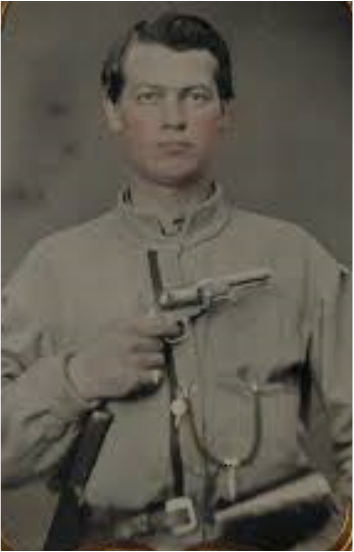
The Colt model 1849 "Pocket Revolver" was Colt's answer when replacing their "Baby Dragoon" series of guns. Produced from 1849-1873, the Model 1849 was Colt's best selling revolver during the 19th century with over 300,000 units produced. While the 1849 gained a solid reputation in the gold fields of California as well as Australia, it saw far wider use a decade later in the American Civil War where combatants on both sides purchased them as personal carry weapons. Though not martially-issued, the Colt Pocket model was an especially popular sidearm with officers, some non-coms and the very lucky few enlisted men who could afford them.This relic was found at the foot of Lookout Mountain 50 plus years ago.
"The Battle of Lookout Mountain was fought November 24, 1863, as part of the Chattanooga Campaign of the American Civil War. Union forces under Maj. Gen. Joseph Hooker assaulted Lookout Mountain, Chattanooga, Tennessee, and defeated Confederate forces commanded by Maj. Gen. Carter L. Stevenson."
The colt's serial number of 51187 would put it in a production year of 1852. This has the 4" octagon barrel in .31 caliber with five-shot cylinder. I purchased this from Lawrence Christopher and he states that the weapon was not excavated but was found on top of the ground. The person that found this weapon told Lawrence that he had found a number of pistol bullets with the skin still on them in the same spot. Also the gun was in pieces and the parts were snapped off the frame by breaking the screws off to "disassemble" the gun. It was fun discussing why the gun was discarded or lost this way. When the gun was discarded the revolver still had two bullets in the cylinder. One can only speculate what activity transpired between the time the soldier loaded the gun with five rounds and the point at which the gun hit the ground in pieces with only two bullets left.
.
(Reference; "Flayderman's Guide to Antique American Arms, 9th Addition", page 88; "The Illustrated History of American Civil War Relics" by Stephen W. Sylvia & J. O'Donnell, page 242; : "Civil War Artifacts A Guide to The Historian" by Howard Crouch, page 94; 'Warman's Civil War Weapons" by Graham Smith, page 22,23; "Standard Catalog of Civil War Firearms" by John F. Graff, page 202; " Standard Catalog of Colt Firearms" by Rick Sapp, page 50; "Civil War Pistols of the Union" by John D. McAulay, page 28-34; "Excavated Artifacts for Battlefields and Campsites of the Civil War" by Stanley S. Phillips 1861-1865", pages 170-172)
"The Battle of Lookout Mountain was fought November 24, 1863, as part of the Chattanooga Campaign of the American Civil War. Union forces under Maj. Gen. Joseph Hooker assaulted Lookout Mountain, Chattanooga, Tennessee, and defeated Confederate forces commanded by Maj. Gen. Carter L. Stevenson."
The colt's serial number of 51187 would put it in a production year of 1852. This has the 4" octagon barrel in .31 caliber with five-shot cylinder. I purchased this from Lawrence Christopher and he states that the weapon was not excavated but was found on top of the ground. The person that found this weapon told Lawrence that he had found a number of pistol bullets with the skin still on them in the same spot. Also the gun was in pieces and the parts were snapped off the frame by breaking the screws off to "disassemble" the gun. It was fun discussing why the gun was discarded or lost this way. When the gun was discarded the revolver still had two bullets in the cylinder. One can only speculate what activity transpired between the time the soldier loaded the gun with five rounds and the point at which the gun hit the ground in pieces with only two bullets left.
.
(Reference; "Flayderman's Guide to Antique American Arms, 9th Addition", page 88; "The Illustrated History of American Civil War Relics" by Stephen W. Sylvia & J. O'Donnell, page 242; : "Civil War Artifacts A Guide to The Historian" by Howard Crouch, page 94; 'Warman's Civil War Weapons" by Graham Smith, page 22,23; "Standard Catalog of Civil War Firearms" by John F. Graff, page 202; " Standard Catalog of Colt Firearms" by Rick Sapp, page 50; "Civil War Pistols of the Union" by John D. McAulay, page 28-34; "Excavated Artifacts for Battlefields and Campsites of the Civil War" by Stanley S. Phillips 1861-1865", pages 170-172)
1836 FLINTOCK PISTOL
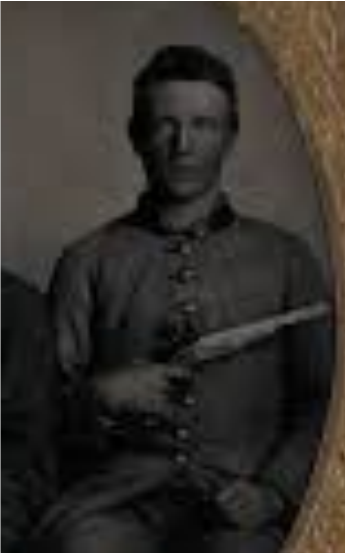
M1836 Flintlock Pistol produced by famed Connecticut maker Robert Johnson of Middletown, Connecticut, in conjunction with Asa Waters of Massachusetts. This was a primary military issue and 41,000 such pistols were produced from 1836 through 1844.The Model 1836 was the last and arguably finest of the flintlock U.S. martial pistols, the standard issue handgun in the Mexican War, and continued to be used into the Civil War. This 14" long weapon is a .54 caliber smooth bore muzzle loader with an 8 1/2" round barrel and has iron furniture. Lockplate maker markings are strong and show "US / R. JOHNSON" / MIDDtn CONN / 1844" in front of the hammer. Stamped on the upper barrel at the breech is "US / JM / P". Maple stock displays two clear inspector's cartouches on the flat opposite the hammer. Stock is strong and shows a pleasing dark patina. Lockplate is flat and beveled ahead of the hammer and round at the rear. Piece has a brass flashpan with a fence that tilts upwards to the read. Mechanics are strong and crisp. Weapon has a swivel type steel ramrod with a button shaped head. All metal areas exhibit a mottled gray patina with scattered spots of oxidation over the surface. It's rare to find these in original flintlock configuration.
(Reference; "Flayderman's Guide to Antique American Arms, 9th Addition", page 330; "The Illustrated History of American Civil War Relics" by Stephen W. Sylvia & J. O'Donnell, page 14; 'Warman's Civil War Weapons" by Graham Smith, page 47)
(Reference; "Flayderman's Guide to Antique American Arms, 9th Addition", page 330; "The Illustrated History of American Civil War Relics" by Stephen W. Sylvia & J. O'Donnell, page 14; 'Warman's Civil War Weapons" by Graham Smith, page 47)
1842 PERCUSSION PISTOL
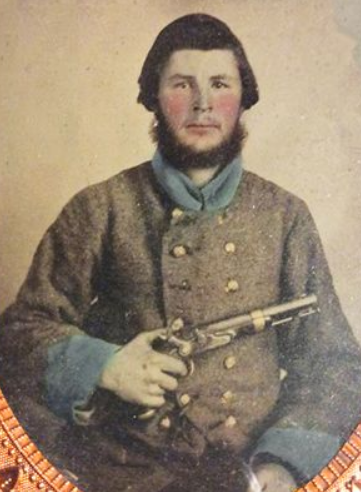
U.S. Model 1842 H. Aston marked single shot percussion pistol. Henry Aston and Ira Johnson, both of Middletown, Connecticut and the Palmetto Armory of Columbia, SC, produced some 24,000 pistols from 1845 through 1852. These pistols were carried in the pommel holsters of dragoons during the western expansion preceding the Civil War and continued in service during the Civil War and were usually in southern hands. They are regarded as strictly Mexican War to early Civil War, but as late as 1864 a Yankee looking over the battlefield at Haws Shop noted scattered horse pistols on the field, apparently lost or discarded by newly arrived Confederate cavalry. If the rebs could capture a yankee revolver, the old single shot wasn't of much use any more. Might as well discard it. Or if you had fired your one shot, and the yanks were getting close, you might decide to turn and run without that anchor slowing you down. This 14" long weapon is a .54 caliber smooth bore muzzle loader with an 8 1/2" round barrel and all brass furniture. Lock plate maker markings are quite good and show "US / H. ASTON" in front of the hammer and "MIDDtn / CONN / 1850" behind the hammer. Stamped on the upper barrel at the breech is "US / GW" and the barrel tang exhibits "1850". Walnut stock displays the inspector's cartouche on the left side near the side plate. Butt of stock does suffer from a hairline crack just above the brass butt cap. Pistol mechanics are strong and crisp. Has a swivel type steel ramrod with a button shaped head. Metal has a nice patina with a few scattered spots of oxidation over the entire surface.
(Reference; "Flayderman's Guide to Antique American Arms, 9th Addition", page 333; "Arms and Equipment of the Confederacy" by Time Life, page 55; "The Illustrated History of American Civil War Relics" by Stephen W. Sylvia & J. O'Donnell, color portfolio; 'Warman's Civil War Weapons" by Graham Smith, page 14; "Standard Catalog of Civil War Firearms" by John F. Graff, page 181; "Civil War Pistols of the Union" by John D. McAulay, page 125)
COLT POCKET RELIC
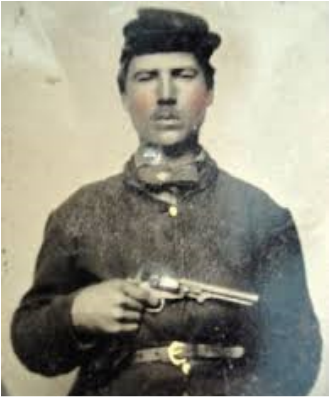
This 31 caliber Model 1849 is called Colt's Pocket Model. This was purchased from Lawrence Christopher of Dalton, Ga. and was excavated off of Lookout Mountain. Lawrence purchased this and a number of other items from the Tennessee Civil War Museum which was closed in 2002. The serial number is 25884 which puts the production date of 1852. The two pieces were found together and no doubt are what's left of a dropped or discarded Colt.
(Reference: "The Illustrated History of American Civil War Relics" by Stephen W. Sylvia & J. O'Donnell, page 242; 'Warman's Civil War Weapons" by Graham Smith, page 22,23; "Standard Catalog of Civil War Firearms" by John F. Graff, page 202; " Standard Catalog of Colt Firearms" by Rick Sapp, page 50; "Civil War Pistols of the Union" by John D. McAulay, page 28-34; "Excavated Artifacts for Battlefields and Campsites of the Civil War" by Stanley S. Phillips 1861-1865", pages 170-172)
(Reference: "The Illustrated History of American Civil War Relics" by Stephen W. Sylvia & J. O'Donnell, page 242; 'Warman's Civil War Weapons" by Graham Smith, page 22,23; "Standard Catalog of Civil War Firearms" by John F. Graff, page 202; " Standard Catalog of Colt Firearms" by Rick Sapp, page 50; "Civil War Pistols of the Union" by John D. McAulay, page 28-34; "Excavated Artifacts for Battlefields and Campsites of the Civil War" by Stanley S. Phillips 1861-1865", pages 170-172)
ENFIELD MUSKET
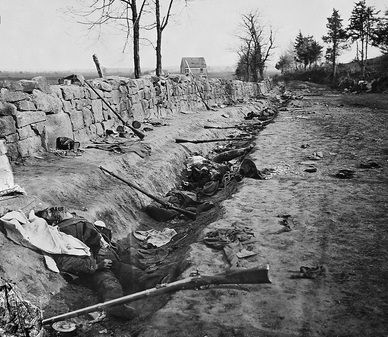 ENFIELDS AMONG THE CONFEDERATE DEAD AFTER THE BATTLE OF FREDRICKSBURG
ENFIELDS AMONG THE CONFEDERATE DEAD AFTER THE BATTLE OF FREDRICKSBURG
.577 cal. Enfield Tower 3 band rifled musket and was an absolute favorite weapon among Confederate Infantry. The English Enfield muskets were developed for the British military and were generally thought to be superior to American made muskets of the period. Many were exported and a number of American military units, both north and south purchased them. Many were smuggled through the blockade to southern ports during the war.This example has a pleasing attic brown patina with lockplate markings of "1862 Tower". The barrel has the distinctive upside down "25-25" markings. The long range site, both sling swivels, and ramrod all remain intact. The stock is complete and very nice with only the small marks of use. It is clearly marked "J Smith" who was the stock maker. This musket came out of central Virginia so almost certainly saw Confederate use. I SOLD THIS ITEM AT AUCTION JUNE 26/10
(References: The Confederate Enfield by Steven W Knott; The Pattern 1853 Enfield Rifle by Peter Smithurst; The English Connection by Russ Pritchard and Corky Huey)
SPRINGFIELD MUSKET
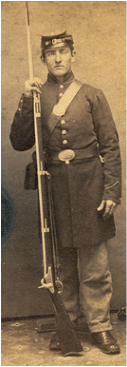
This Model 1861 was the standard rifle-musket used throughout the war. It was originally made by the Springfield Armory, but due to the need for more firearms, the U.S. government contracted with twenty private contractors. It is estimated that about one million Model 1861–type muskets were manufactured during the war. It was a modification of the Model 1855 rifle-musket that eliminated the patch box and the Maynard tape primer. These changes lowered its manufacturing costs and time, both of which were beneficial to a country at war and in need of firearms. This model 1861 Springfield musket is dated 1862. It is identified to a 76th Regiment infantry soldier. The musket is all original and has the sling mounts, rings and ram rod. The ram rod channel is in great shape. Stock has no problems and has the soldier's name "John Hoder" carved in it. There are often initials carved in weapons but very seldom do you find a complete name.It turns out there is only one soldier with that name and he survived the war. I SOLD THIS ITEM AT AUCTION JUNE 26/10
(Reference "The Illustrated History of American Civil War Relics" by Stephen W. Sylvia & J. O'Donnell, page 198; "Civil War Artifacts A Guide to The Historian" by Howard Crouch, pages 84,85, 87; "Civil War Relics of the Western Campaigns" by Charles S. Harris, page 86; The U.S. Model 1861 Springfield Rifle-Musket 2nd Edition by James B. Whisker, Daniel D. Hartzler and Larry W. Yanz, pages Introduction to page 38)
